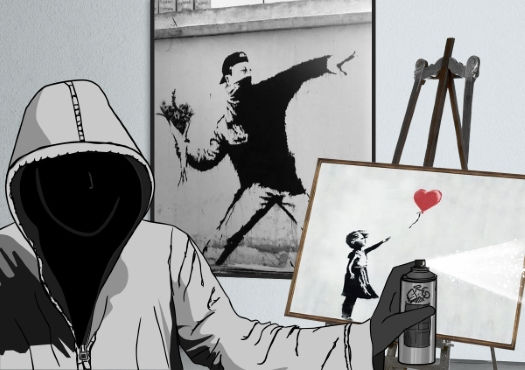
British Graffiti Artist, Political Activist, and Film Director


Summary of Banksy
With tongue firmly planted in cheek, English graffiti artist and international prankster Banksy has managed to become one of the world's most recognized artists while remaining relatively anonymous. Staying true to the credos of Street Art , he's built a celebrated body of work, both permanent and impermanent, that utilizes satire, subversion, dark humor, and irony to create resonant social, political, and humanist messages for the masses on a populous and public level. His style is universally familiar, founded on a signature stencil aesthetic that has elevated him from mere man with a spray can to a highly creative artist in his own right. He is responsible for catapulting guerilla work into the mainstream as a viable form of art.
Accomplishments
- Banksy's artistry lies in his ability to use humor and sardonic wit to trick viewers into contemplating the underlying seriousness of his messages about capitalism, advertising, politics, and humanity. It is this very sense of innocent whimsy coupled with daring, glaring truths about our times that lift him to a role as potent social mediator all under the guise of art.
- Regardless of his fame, Banksy's chosen canvas remains the street and improvisational public places where his art can 'pop up" guerrilla-style retaining its resistance to being commercialized within any specific social sector, audience, or market.
- Anonymity has been Banksy's main way to operate, largely because it removes the status of artist as celebrity and instead forces a focus on the artwork. It also allows for the freedom of telling one's unapologetic truth without regard to consequence.
- In an ironic twist of fate, Banksy's subversive mien has only furthered his crossover to mainstream acceptance as the world takes note of his signature style and lack of any noted ego drive toward artistic recognition. The artist himself has become a bridge not unlike the ones his artwork aims to build.
- Because graffiti is illegal, Banksy's work continues to raise questions in the social sphere about the lines between public art and vandalism. If his work on the side of a building becomes a collectible, protected piece while another less known street artist is jailed for performing a similar action, what does this signify about the hypocrisy afforded to fame?
The Life of Banksy
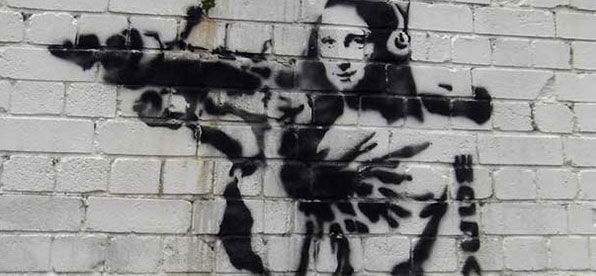
Whether Banksy is one person, or a group of people we don't know. But it is a fact that he (she, or it) has created some of the most powerful, controversial, witty, and brilliant contemporary art.
Important Art by Banksy

Kissing Coppers
In this iconic image, two (seemingly male) police officers in full, typical British uniforms are depicted kissing, in what appears to be a loving embrace. This work was originally spray-painted on the side of the Prince Albert pub in Trafalgar Street near the downtown core of the city of Brighton. Before its creation, one of Banksy's associates approached the pub owner on his behalf to seek permission for the work. The pub owner says, "My first thought was, 'oh no'. I thought we'd get in loads of trouble for it." But to his delight, after its creation, a group of uniformed officers appeared in front of the pub to view the piece and proceeded to take pictures. In 2011, the piece was replaced with a copy protected by a Perspex case, while the original was flown to the United States to be sold at auction. The piece can be read in many ways. In one respect, Banksy is advocating for a sexual-identity accepting society by placing icons of authority in a pro-gay position. His use of policemen, rather than ordinary citizens, is intriguing, because the very subjects of his tender portrayal are often the ones to working to eradicate his vandalism. While some believe that he is poking fun at policemen, showing them in a vulnerable, intimate moment, others read the work more positively, as showing a human side to the police force, and emphasizing the strong bonds that exist on the police force between partners and teammates. The work is an undeniable testament to Banksy's use of irony to challenge us to build a bridge of understanding between expected enemies of ideology.
Spray paint - Originally painted in Brighton, England. Now in private collection

Rage, the Flower Thrower
This work, now covered and protected by a Perspex overlay, features a man dressed up in what we associate with traditional riot gear, with a bandana obscuring his face, and his cap on back-to-front. His stance is one of a person about to lob a Molotov cocktail; he's taking aim and is ready to throw his weapon. However, instead of a weapon, he holds a bunch of flowers (which are the only part of the mural to appear in color.) This piece is located on a wall on the side of a garage in Jerusalem on the main road to Beit Sahour, Bethlehem. By substituting a weapon with a bunch of flowers, Banksy is advocating for peace, and he opted to install this particular message in a high-conflict area. The work also carries the message idea that peace comes with active hard work. In addition, the bouquet may as also represent a commemoration of lives lost in the long-running Israeli-Palestinian conflict - and thus, his use of art to relay messages of social importance.
Stencil and spray paint - Bethlehem

Napalm Girl
Again, Banksy has taken a pre-existing image - in this case an iconic photograph from Vietnam in 1972, of a girl - Kim Phuc - fleeing from a napalm attack on her village. The original photograph was taken by associated press photographer Nick Ut and has developed into a short hand for the atrocities of the Vietnam War. Banksy has isolated the image of the horror-stricken girl (originally surrounded by a few other clothed children and seven soldiers running down a road away from the site of the napalm attack) and flanked her with Mickey Mouse and Ronald McDonald. These two instantly recognizable, smiling characters, when juxtaposed with the image of Napalm Girl, give the image a very twisted and sinister feel. Both Mickey Mouse and Ronald McDonald are two family-friendly faces of American capitalism, the same country that dropped Napalm on Vietnam. Banksy's work then becomes a critique of not just America but also of capitalism. The girl's horror-stricken face is juxtaposed against the two characters' big, bright smiles. In this simple image, Banksy shows both the fun, carefree facade of American culture, and the reality that America also has a very dark, underbelly which drops bombs on people, and both commercializes and glamorizes war. Banksy once stated that "The greatest crimes in the world are not committed by people breaking the rules but by people following the rules. It's people who follow orders that drop bombs and massacre villages."
Screenprint on paper

Show Me the Monet
This work by Banksy refigures the iconic Impressionist painting Bridge Over a Pond of Water Lillies (1899) by Claude Monet. Monet's original reveals a tranquil scene of his own garden, with rich vegetation reflected in the calm water. Banksy has replicated Monet's original painting almost exactly, using the same materials as Monet, however Banksy has added two discarded shopping carts and a traffic cone to the pond. By using shopping carts, an image associated with consumerism, Banksy’s message is that society is focused on material goods, buying more than is necessary in a futile attempt to make itself feel happy and fulfilled. Moreover, by representing these man-made objects as discarded in an otherwise beautiful setting, he critiques contemporary society's disregard for nature in favor of commodity fetishism and the production of excessive waste. Even in the title Banksy has subverted the meaning of the Impressionist painting, with the word "money" being a play on "Monet".
Oil on canvas
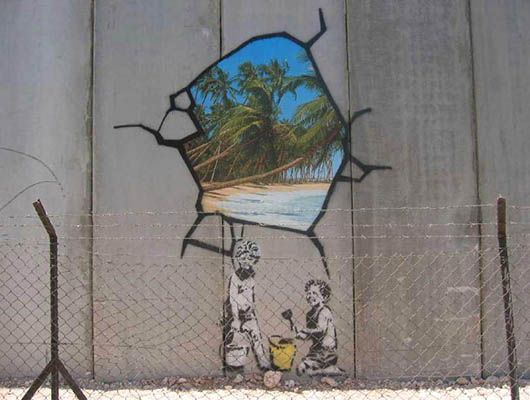
Unwelcome Intervention
This mural depicts two young boys playing with buckets and shovels, like children creating sandcastles on a beach. The boys, one standing, the other kneeling, look back at the viewer, rendered in Banksy's typical black and white stencil aesthetic. Just above the boys, the artist has created the illusion of a broken section of the grey wall on which the mural was created. Through this false hole, a photorealistic color image of a tropical beach paradise is visible. As with much "guerrilla" Street Art, the location of the piece plays a central role in its meaning. Banksy stenciled this work onto the Israeli-Palestinian West Bank barrier wall in August 2005 along with eight other murals (including a dove with a bulletproof vest and a heart-shaped target over its chest, a child beneath a ladder stretching to the top of the wall, and the silhouette of a young girl being lifted upwards by a bunch of balloons). While the Israelis consider the wall to be a protection against terrorism, the Palestinians claim that its purpose is racial segregation. Banksy's spokeswoman Jo Brooks said that while Banksy was creating the piece, "The Israeli security forces did shoot in the air threateningly and there were quite a few guns pointed at him." However, Banksy questioned, "How illegal is it to vandalize a wall if the wall itself has been deemed unlawful by the International Court of Justice?" This piece plays on the notion that the grass may be greener, and the landscape (perhaps environmental, perhaps political) may be better on the other side of this large barrier (although we know that it isn't). The artist may also be suggesting that a better political landscape could only emerge if the barrier were destroyed. By including children in this, and several others of the murals on the wall, the artist forces us to consider the toll that the local conflict takes on the innocent. The viewer is even more strongly implicated in the work through the direct gaze of the children. When painting these murals in 2005, Banksy had a conversation with a Palestinian man who told him, "You paint the wall, you make it look beautiful," to which Banksy replied, "Thanks." The Palestinian man then said, "We don't want it to be beautiful, we hate this wall, go home."
Paint - West Bank barrier wall

One Nation Under CCTV
This work on Newman Street in London was painted on the wall of a building used by the Royal Mail. At the bottom right, a child in a red hooded sweatshirt, black shorts, and a grey backpack, is seen painting the phrase "ONE NATION UNDER CCTV" while being watched by a police officer and a dog at the bottom left. The mural was situated in the line of sight of a CCTV camera. In fact, Banksy managed to erect three stories of scaffolding under the cover of darkness to create the entire artwork in one night. This work aims to criticize the excessive surveillance (both from CCTV cameras in public spaces, as well as in other forms such as online) that has recently become a controversial issue both in the UK and abroad. Banksy has done other works that aim to "tease" security cameras, for instance by stenciling the words "what are you looking at?" on a blank wall faced by a CCTV camera. The Westminster City Council stated in October 2008 that the work would be painted over, regardless of the celebrity status of the artist, as it was illegal graffiti. The council stated that Banksy "has no more right to paint graffiti than a child." Robert Davis, the chairman of the council planning committee told The Times , "If we condone this then we might as well say that any kid with a spray can is producing art." The work was eventually painted over in April 2009. The condemning of Street Art as illegal vandalism, and its frequent removal, has been the focus of many other works by Banksy. But on the other hand, the fact that many of his works get removed shortly after their creation adds to the excitement and fanaticism that surrounds Banksy's work. Banksy biographer Will Ellsworth-Jones wrote in 2013 that Banksy "is an artist who has got people running around the city desperate to see his work before it gets painted over."
Spray paint
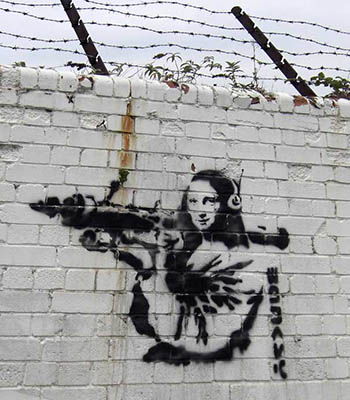
Mona Lisa Bazooka
In this work, Banksy plays upon one of the world's most famous paintings, The Mona Lisa (1503-4). Although in his piece, the female protagonist wears a headset while aiming a rocket launcher in his typical black and white stencil style. The piece first appeared in the Soho district of West London. While Banksy's juxtaposition of art history's most famous female with a powerful modern weapon may certainly be cheeky, there is more that can be read into the image. While da Vinci's Mona Lisa appears graceful and passive, Banksy gives her a powerful, confrontational, and active sensibility. Her facial expression remains just as calm as in the original, however, next to the powerful weapon, her welcoming smile is menacing, in a much more horrific manner. It can also be read as a statement on how blasé citizens have become to the ongoing realities of war, always taking place somewhere far removed from their own tranquil lives.

Power Washer
This mural depicts a maintenance worker in an orange vest pressure washing art from a wall. The act seemingly destroys an ancient cave painting, a painting that is quite similar to the wonderous discovery at the time in France. With this work, Banksy is drawing a parallel between the prehistoric cave paintings, and modern-day graffiti. While it is standard practice for the latter to be cleaned off of walls, it would be unthinkable for the same fate to befall the former. In this way, the artist questions the value placed on certain works of art, and the label of "vandalism" assigned to others.

This more recent Banksy work serves as an excellent example of the way that guerrilla Street Artists use the surrounding environment as an integral part of their works. In this work, Banksy has stenciled a simple black silhouette of a child with a large mallet in the process of striking something in front of him. The pre-existing object that the boy is about to hit is a red fire hydrant (or rather, a siamese connection for the fire department) which has a pipe coming up through the top leading directly to a round red object several feet higher (possibly a fire alarm). With the inclusion of the small boy with the mallet, this utilitarian plumbing fixture is instantly transformed to look like a "strength tester" (the classic carnival game where a player must strike a mallet to hit the bell at the top). With site-specific works like Hammer Boy , Banksy and other Street Artists encourage viewers to envision urban spaces, surfaces, and objects differently, and to see fun and whimsy in otherwise mundane surroundings. In this way, Street Artists have much the same mentality as skateboarders or people who practice parkour. For all of these groups, city spaces and surfaces are not restricted to their prescribed uses. Instead, participants feel the freedom to co-opt and repurpose the urban environment. A fire hydrant is not just for holding water, it can also become a child's plaything. A handrail is not only for holding and supporting oneself, it can also become a tool for enacting daring acrobatic feats.
Spray Paint - 79 th Street, New York City

Love is in the Bin
In October 2018, Banksy’s iconic image of Balloon Girl , featuring a young girl letting go of a heart-shaped balloon as a beacon of innocent hope, was sold during a Sotheby’s auction for 1.04 million pounds. The moment it was pronounced “sold,” a strange alarm sounded from within the painting’s frame, its trigger source unknown. Immediately, the painting started to descend down through its bottom, which turned out to be a shredding mechanism. Although the painting was supposed to shred fully as Banksy later admitted, the device stopped working, leaving half the painting intact in the frame. Banksy posted a video of the shredding with the words “Going, going, gone” on his Instagram page, leading people to believe he had planted a subversive ally in the auction room. But he removed the video promptly, after it had successfully winked at his social media audience. The female buyer decided to keep the work, newly retitled Love is in the Bin , as it was now the subject of a grand scandal, the only artwork created at a live auction in history, and cemented her in the status of purchaser of one of the art world’s most notorious capers. Joey Syer, co-founder of an art dealing website, was quoted in the Evening Standard as saying, “The auction result will only propel this further and given the media attention this stunt has received, the lucky buyer would see a great return on the 1.02M they paid last night, this is now part of art history in its shredded state and we’d estimate Banksy has added at a minimum 50% to its value…” Banksy would go on to release a video showing how the shredder was installed into the frame upon its creation, stating it was purposefully crafted in case the work ever made it to auction. His reasoning came in the form of the quote: “The urge to destroy is also a creative urge.”
Biography of Banksy
Very little is known of Banksy's youth, as he continues to keep his true identity a secret. It is reported that he played (as goalkeeper) with the Easton Cowboys football club during the 1990s and early 2000s. According to Will Simpson, another long-time member of the Easton Cowboys, Banksy went on tour with the team to Mexico in 2001 and painted a number of murals in the communities they played in, including one painting that was "raffled off to raise money for water projects in Chiapas in southwestern Mexico."
According to investigation of several alleged former schoolmates and associates, along with indication by the geographic locations of Banksy's work, the artist is believed to be Robin Gunningham, a former student at the public Bristol Cathedral School. There has also been speculation that rather than being a single person, Banksy is a team of seven artists.
Education and Early Training
Because of his anonymity, not much can be surmised about Banksy's education or training in art. Yet, from very early on in his career we find a creative proficiency with using original imagery to develop his own unique voice - one that combined controversial and humorous visuals to create anti-war, anti-capitalism, and anti-establishment messages.
In the early 1990s, Banksy began working as a freehand graffiti artist with the DryBreadZ Crew (DBZ) in his hometown of Bristol. Around 1994, he turned to stencil art, inspired by fellow street artist 3D who later became a founding member of the band Massive Attack. Stencils are traditionally hand drawn or printed onto sheets of acetate or card stock, and then cut out by hand. The stencils are then affixed to a surface, such as a wall, and spray-painted. When the stencil is removed, the image remains. This first signature tool allowed Banksy to execute pieces on the fly. Like many street artists, he adopted common recurring motifs such as apes, policemen, soldiers, rioters, children, and the elderly to mark his stamp in public spaces, which quickly began to garner a following. By proliferating these iconic-stenciled images around Bristol and London, he rapidly gained the attention of the street art community and the general public.
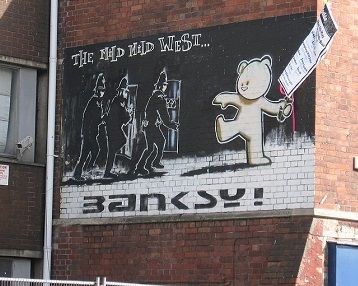
A prototypical street artist, Banksy justified his vandalism of public space, and his use of the city as canvas, as being a direct response to what he called "Brandalism," or, "any advertisement in public space that gives you no choice whether you see it or not...The people who truly deface our neighborhoods are the companies that scrawl giant slogans across buildings and buses trying to make us feel inadequate unless we buy their stuff. They expect to be able to shout their message in your face from every available surface but you're never allowed to answer back. Well, they started the fight and the wall is the weapon of choice to hit them back."

Banksy also frequently used rats in his art, as did his predecessor, the street artist Blek le Rat, who once stated, "I began to spray some small rats in the streets of Paris because rats are the only wild animals living in cities, and only rats will survive when the human race disappears and dies out." In Banksy's work, these nocturnal creatures (to most people associated with disease and infestation) can be understood as a sort of pseudonym or self-portrait of the artist who completes his illegal works under the cover of darkness.
Banksy said, "If you feel dirty, insignificant, or unloved, then rats are a good role model. They exist without permission, they have no respect for the hierarchy of society, and they have sex 50 times a day." The word "rat" also serves as an anagram of "art," although Banksy has admitted that he painted rats for several years before someone made him aware of this fact. Rats also happen to be rare vermin that resist deep hatred by humans, and have the survival skills to get by – somewhat like Street Artists that evade authority and operate often under the cover of darkness.
In the 1990s he met Bristol photographer Steve Lazarides, who began photographing Banksy and his work, and then went on to become his agent until 2009. Lazarides recently stated, "When I first met this scruffy, grumpy guy back in 1997, I would have never guessed that 20 years on he would be the most famous artist of his generation, and that his work would be studied on school curriculums." He also says, "I worked with him [Banksy] for 11 glorious years, during which time we broke every rule in the art rule book along with a fair few laws. He has since gone on to become a global superstar and has retained his ability to shock and make people chuckle."
After Banksy's professional relationship with Lazarides ended, he created his own organization, Pest Control, which acts as sole representative and contact liaison for his work, in charge of verifying authorship of his pieces and issuing documents of provenance to buyers.
Mature Period
In the early 2000s, Banksy evolved from stenciling the streets to creating prankster projects, staging public interventions within well-established art institutions, and organizing exhibitions in addition to continuing with his unsanctioned public works, all the while retaining his carefully cloaked invisibility within the public eye. Much of these efforts poked fun at art as commodity, or made specific statements on the way we are force-fed popular culture through mainstream mass distribution, and challenged our common culpability in consuming marketing, political, or media messages as truth.
In the early 2000s, Banksy began holding exhibitions and performing interventions within well-established art institutions, in addition to continuing with his unsanctioned public interventions. For example, he produced 100,000 fake British £10 bills, putting in a photo of Diana, Princess of Wales, and updating text to "Banksy of England".
In March 2005, he surreptitiously placed modified versions of artworks (such as a Warhol-esque painting of a discount soup can) in the Museum of Modern Art, the Metropolitan Museum of Art, the American Museum of Natural History in Manhattan, and the Brooklyn Museum in Brooklyn.
In August/September of 2006, Banksy placed approximately 500 copies of Paris Hilton's debut CD, Paris , in 48 record stores around the UK, modified with his own cover art (Photoshopped to show Hilton topless). Other versions featured: Paris with her Chihuahua, Paris with Tinkerbell's head replacing her own, or Paris stepping out of a luxury car amongst a group of homeless people, which included the caption "90% of success is just showing up." Music tracks were given titles such as "Why Am I Famous?" "What Have I Done?" and "What Am I For?" Members of the public purchased many copies of the guerilla CD before stores were able to remove them. The purchased copies went on to be sold for as much as £750 on online auction websites.
In September 2006, Banksy dressed an inflatable doll in an orange jumpsuit, black hood, and handcuffs in resemblance of a Guantanamo Bay detainment camp prisoner. He then placed the doll below the Big Thunder Mountain Railroad ride at the Disneyland theme park in Anaheim, California, where it remained for 90 minutes before the ride was shut down and the figure removed. By placing a harsh symbol of political reality within a noted escapist environment, Banksy was remarking on our propensity for keeping our eyes wide shut.
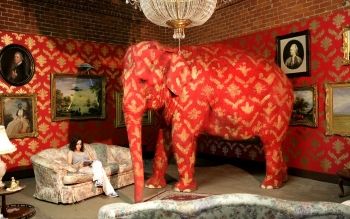
At his Barely Legal exhibition of 2006 in Los Angeles, which drew a celebrity crowd including Brad Pitt and Angelina Jolie, Banksy rented a live 38-year old female Indian elephant named Tai, painted in the same red and gold floral pattern as the wallpaper behind it. This “elephant in the room” was meant as a reminder of our ongoing ignorance of poverty around the world. Due to rights activists complaints, the elephant was not painted for the final day of the show, even though her handlers said that she had done "many, many movies [and is] used to makeup,” meaning that painting her was not a form of mistreatment.
In London, over the weekend of May 3-5, 2008, Banksy hosted an exhibition titled The Cans Festival (a play on words of the famous French film festival Cannes ). Stencil artists from around the world (including Faile from Brooklyn, Bandit from the Netherlands, Run Don't Walk from Argentina, and James Dodd from Australia) were invited to paint their original artwork, as long as it did not cover or interfere with anyone else's. It took place in a road tunnel formerly used by Eurostar underneath the London Waterloo station. The location was kept secret while the works were completed, and only then revealed to the public. Eurostar agreed to leave the works intact for at least six months following the event.
In August 2008, three years after Hurricane Katrina and the associated levee failure disaster, Banksy produced a series of work in New Orleans, Louisiana, mostly on buildings that had yet to be repaired. He said, "Three years after Katrina I wanted to make a statement about the state of the cleanup operation." He also painted on the rebuilt levee wall, which according to him offered "the best painting surface in the state of Louisiana."
On June 13, 2009, the Banksy vs. Bristol Museum exhibition opened at Bristol City Museum and Art Gallery. The show featured more than 100 artworks (78 of which were new works), including animatronics, sculptures, and installations. The show drew over 8,500 visitors on the first weekend, and over 300,000 over the course of twelve weeks.
In December 2009, Banksy marked the end of the 2009 United Nations Climate Change Conference by painting four murals on global warming. One included the phrase, "I don't believe in global warming," submerged in water.
At the London Zoo, Banksy climbed into the penguin enclosure and painted "We're bored of fish" in 7-foot-high letters. He also left the message "I want out. This place is too cold. Keeper smells. Boring, boring, boring." in the elephant enclosure.
In 2010, Banksy's oeuvre expanded into filmmaking after he employed aspiring street artist Thierry Guetta as an assistant and documentarian on several visits to Los Angeles. He encouraged Guetta to pursue making art, which he did, closely following Banksy's example to ultimately become the branded graffiti artist Mr. Brainwash. This journey became the focus of Banksy's 2010 documentary Exit Through the Gift Shop , which was nominated for an Oscar. Banksy released a statement about the nomination saying: "This is a big surprise... I don't agree with the concept of award ceremonies, but I'm prepared to make an exception for the ones I'm nominated for. The last time there was a naked man covered in gold paint in my house, it was me."
From August 21 through September 27, 2015, Banksy opened Dismaland in Weston-super Mare, United Kingdom. The large-scale group show, which included artists Damien Hirst and Jenny Holzer, was a dark and twisted take on Disneyland. The temporary theme park featured a gloomy castle and an overturned Cinderella's carriage.
A lso in 2015, Banksy created several murals in response to the Syrian refugee crisis, which were located in the area of Calais, France’s “jungle”—a site heavily packed with migrants attempting to enter the country. One of these murals ironically depicted Apple founder Steve Jobs, because as the artist described, “We're often led to believe migration is a drain on the country's resources, but Steve Jobs was the son of a Syrian migrant. Apple is the world's most profitable company, it pays over $7bn a year in taxes – and it only exists because they allowed in a young man from Homs.”
2017 saw Banksy collaborating with artists Sami Musa and Dominique Petrin to design the Walled Off Hotel , a real space of lodging in Bethlehem that the artist financed to mark the 100 th anniversary of British control in Palestine. Also, housing an art gallery, the hotel was tightly surrounded by a wall that each of the bedrooms directly faced, rather than the prototypical vacation views. Although Banksy’s work shows a clear predilection for views in support of social justice, pieces created in this geographical area, have come under criticism by people and organizations such as Change.org because of their one-sided, sometimes borderline anti-semitic, messages.
In 2018, Banksy returned to New York City after a five-year absence for a graffiti spree that titillated the public with a spray of fresh works. Some works, such as a trademark rat running around a large clock face, were torn down quickly but others such as a portrait of imprisoned Kurdish artist Zehra Dogan on the Bowery Wall became adopted works into the fabric of the city.
The end of 2018 would bring to light a stroke of artistic genius from Banksy, in an unforgettable pre-strategized prank that rocked the art world’s stuffy foundation. One of Banksy’s prior works Balloon Girl was sold at a Sotheby’s auction for 1.04 million pounds, yet just as the gavel sound confirmed the piece was sold, an alarm sounded from inside the picture frame and the piece started to pass through a shredder that had been buried inside. The antic would go down in history as presenting the first piece of artwork, created guerilla-style, in the midst of an auction.

The event would also represent an evolution in Banksy’s nearly two decades long career where the artist’s strict anonymity had become concretely replaced by a worldwide recognition so vast, it would inevitably change the future course of his works. No longer abetted by the street art underground’s codas of secrecy, Banksy had become undeniably familiar, accepted, easily recognized, and sought after by the public at large. This became blindingly clear in 2018, when he painted the mural Season’s Greetings on a garage in Wales. The two-sided piece depicted a child tasting snowflakes which were revealed to be smoke and embers from a fire. The town was immediately abuzz about the possibility of the work being done by Banksy, the garage owner expressed fear and anxiety over the responsibility of protecting the piece from vandalism, and eventually a plastic screen and security guards were funded to cover the work.
This new reality has manifested in an emerging visibility by Banksy, of which he remains unseen yet engages on social media applications such as Instagram with his public; it is a place fans and collectors follow now to confirm authorship of Banksy’s works as he actively posts new pieces and claims creation.
His art continues to tantalize the status quo and shed light on our societal woes. Staying ever relevant within the arena of current events, Banksy recognized healthcare workers on the front line of the coronavirus pandemic in 2020 by creating, dedicating, and donating a painting to the University Hospital of Southampton.
The Legacy of Banksy
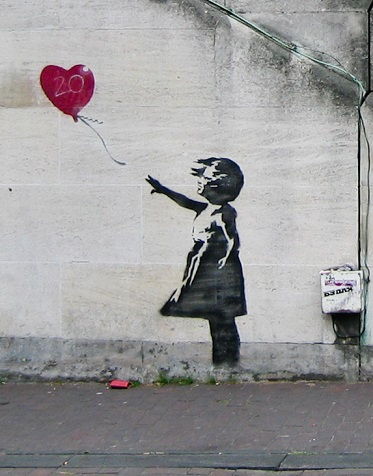
On May 21, 2007 Banksy was selected to receive an award for Greatest Living Briton. Along with other artists like Shepard Fairey, Zevs, D*Face, and Ron English, he is credited with transforming graffiti from the typical "bubble writing" style of the 1980s to the "narrative-driven street art" of today. This contemporary street art varies significantly in aesthetic and materials, from Banksy's stencils, to Swoon's wheat paste posters, to Zevs' "liquidated logos" technique, to Space Invader's tile art. Other street artists, such as his protégé Mr. Brainwash, have adopted Banksy's particular style of instantly recognizable images such as corporate mascots and famous historical paintings.
This "guerrilla art," also referred to as "post-graffiti art," which Banksy helped develop, often plays heavily upon location and context as part of the work, and seeks to regain power from stronger enemies (such as corporations and governments). These artists accomplish this by carrying out interventions in corporate and government spaces (such as billboards, storefronts, and barrier walls), and by co-opting corporate and government images (such as logos, mascots, political figures, and official currency). Banksy has also pioneered the use of alternative venues for the display of street art, as in his 2003 exhibition Turf War , which was staged in a warehouse on Kingsland Road in London's East End.
Moreover, his art has sold for extremely high prices at auction, with pieces being purchased by collectors and celebrities alike for millions of dollars, making Banksy one of the first street artists to become part of the commercial art market. However, this commercial success troubles the artist, who says that "Commercial success is a mark of failure for a graffiti artist," and "We're not supposed to be embraced in that way." He continues to believe that "When graffiti isn't criminal, it loses most of its innocence." This is an ongoing controversy in the art world, with many artists being seen as "sell-outs" when they embrace the mainstream art world success. Banksy's establishment of representatives and liaisons for points of sale of his work has furthered this controversy. However, many other street artists (including equally famous Shepard Fairey) argue that they use this legitimate income to fund further illicit, unsanctioned guerrilla art.
Banksy's reception on a universal scale has also legitimized graffiti as a viable form of public art, furthering debate between vandalism as criminal activity and vandalism as an artist's creative medium (in a way, becoming a symbol of freedom). Many of his works remain on buildings and other public spaces because of their contemporary value, even if at the time of their creation, they were seen as illegally concocted. In fact, many building owners have benefitted from becoming "owners" of an original Banksy.
Influences and Connections

Useful Resources on Banksy
- Banksy: The Man Behind the Wall Our Pick By Will Ellsworth-Jones
- Banksy: Art Breaks the Rules By Hettie Bingham
- Banksy in New York By Ray Mock
- Banksy. Myths & Legends: A Collection of the Unbelievable and the Incredible By Marc Leverton
- Banksy, Banging Your Head Against a Brick Wall
- Banksy, Existencilism
- Banksy, Cut It Out
- Banksy, Wall and Piece Our Pick
- Banksy, Pictures of Walls
- Banksy: You Are an Acceptable Level of Threat By Gary Shove, Patrick Potter, and Banksy
- Where's Banksy?: Banksy's Greatest Works in Context By Xavier Tapies
- Banksy: Urban Art in a Material World by Ulrich Blanché and Rebekah Jonas
- Banksy Locations & Tours Volume 1: A Collection of Graffiti Locations and Photographs in London, England By Martin Bull
- Banksy Locations & Tours Volume 2: A Collection of Graffiti Locations and Photographs from Around the UK By Martin Bull
- This Is Not a Photo Opportunity: The Street Art of Banksy By Martin Bull
- Banksy's Bristol: Home Sweet Home By Steve Wright and Richard Jones
- Official Banksy Website Our Pick
- Banksy's art hotel in Bethlehem
- The Story Behind Banksy By Will Ellsworth-Jones / Smithsonian Magazine / February 2013
- The Law of Banksy: Who Owns Street Art? Our Pick By Peter N. Salib / The University of Chicago Law Review / 2015
- 'This is not a Banksy!': Street Art as Aesthetic Protest By Susan Hansen / Continuum: Journal of Media & Cultural Studies / 2015
- Whose Place Is This Anyway?: The Israeli Separation Barrier, International Activists and Graffiti By Robert R. Sauders / Anthropology News / March 2011
- Exit through the Gift Shop Our Pick Feature length documentary film directed by Banksy, nominated for a 2010 Oscar for Best Documentary Feature
- How to Sell a Banksy Feature length documentary film by Alper Cagatay and Christopher Thompson
- $aving Banksy Trailer for documentary film directed by Colin Day
- Banksy does New York Feature length HBO documentary film
Similar Art

Free South Africa (1985)
Related artists.

Related Movements & Topics

Content compiled and written by Alexandra Duncan
Edited and revised, with Summary and Accomplishments added by Kimberly Nichols
Banksy is the pseudonym of a street artist known for his controversial, and often politically themed, stenciled pieces.

Circa 1974-present
Latest News: Lost BBC Interview Hints at Banksy’s Identity
A recently discovered recording from 2003 might have solved part of the mystery behind the identity of anonymous street artist Banksy. During that interview, former BBC arts reporter Nigel Wrench asks Banksy if he could use his real name in the interview, citing a report from The Independent referring to him as “Robert Banks.” When Wrench asks the artist to confirm if that’s his name, he answers, “It’s Robbie.”
Banksy’s identity has long been the subject of speculation, with Massive Attack’s Robert Del Naja and Gorillaz co-creator Jamie Hewlett among the names linked to the artist. The Daily Mail reported in 2008 that Banksy was then-34-year-old Robin Gunningham, though he has denied this.
Who Is Banksy?
Banksy’s identity, "the banksy effect".
Banksy, whose real identity remains unknown, is a street artist believed to have been born in Bristol, England, around 1974. He rose to prominence for his provocative stenciled pieces in the late 1990s. Banksy is the subject and director of the 2010 documentary Exit Through the Gift Shop that examines the relationship between commercial and street art. He was nominated for an Academy Award for Best Documentary Feature for the project.

Banksy began his career as a graffiti artist in the early 1990s, in the Bristol, England–based graffiti gang DryBreadZ Crew. Although his early work was largely freehand, Banksy used stencils on occasion. In the late 1990s, he began predominantly using stencils. His work became more widely recognized around Bristol and in London, as his signature style developed.
Banksy’s artwork is characterized by striking images, often combined with slogans. His work often engages political themes, satirically critiquing war, capitalism, hypocrisy, and greed. Common subjects include rats, apes, policemen, members of the royal family , and children. In addition to his two-dimensional work, Banksy is known for his installation artwork. One of the most celebrated of these pieces featured a live elephant painted with a Victorian wallpaper pattern and sparked controversy among animal rights activists.
Other pieces have drawn attention for their edgy themes or the boldness of their execution. Banksy’s work on the West Bank barrier, between Israel and Palestine, received significant media attention in 2005. He is also known for his use of copyrighted material and subversion of classic images. An example of this is Banksy’s version of Claude Monet ’s famous series of water lilies paintings adapted to include drifting trash and debris.
In a 2003 interview, a BBC reported asked the artist whether graffiti artwork should be considered vandalism. “If it’s done properly, it is illegal! But I got a good reaction I think off most people from my work,” Banksy replied, according to Rolling Stone . “You know, I’ve even had policemen in the past say they kind of like things about it, but… I just think it’s my right to go out and paint it.”

Banksy’s identity remains unknown, despite intense speculation. The two names most often suggested are Robert Banks and Robin Gunningham. Pictures that surfaced of a man who was supposedly Banksy pointed toward Gunningham, an artist who was born in Bristol in 1973. Gunningham moved to London around 2000, a timeline that correlates with the progression of Banksy’s artwork.
Making Banksy’s identity potentially harder to pin down is the suggestion by journalist Craig Williams and others that Banksy is a collective of artists working together under the same brand. However, news broke in November 2023 that the artist said his name was “Robbie” in a BBC interview conducted two decades previously.
According to Smithsonian Magazine , an ongoing lawsuit threatens to reveal Banksy’s full name once and for all. A greeting card company called Full Color Black is suing the artist for defamation over a now-deleted Instagram post from 2022. After a Guess clothing store used one of Banksy’s works as part of a window display in collaboration with Brandalised—of which FCB is the trading company—the artist posted: “Alerting all shoplifters. Please go to Guess on Regent Street. They’ve helped themselves to my artwork without asking, how can it be wrong for you to do the same to their clothes?”
FCB is seeking at least $1.6 million in damages and wrote in its filing that the “claimant reserves the right to seek an order that he identifies himself for the purposes of these proceedings.”
Banksy’s worldwide fame has transformed his artwork from acts of vandalism to sought-after high art pieces. Journalist Max Foster has referred to the rising prices of graffiti as street art as “the Banksy effect.” Interest in Banksy escalated with the release of the 2010 documentary Exit Through the Gift Shop .
The movie, which premiered at the Sundance Film Festival, was nominated for an Academy Award. Banksy requested the ability to attend the ceremony in Los Angeles in disguise, which the Academy ultimately rejected.
In October 2013, Banksy took to the streets of New York City. There, he pledged to create a new piece of art for each day of his residency. As he explained to the Village Voice , “The plan is to live here, react to things, see the sights—and paint on them. Some of it will be pretty elaborate, and some will just be a scrawl on a toilet wall.” During that month, he also sold some of his works on the street for $60 a piece, well below the market value for his art.
- We can’t do anything to change the world until capitalism crumbles. In the meantime we should all go shopping to console ourselves.
- People say graffiti is ugly, irresponsible, and childish. But that’s only if it’s done properly.
- People who should be shot: Fascist thugs, religious fundamentalists, people who write lists telling you who should be shot.
Fact Check: We strive for accuracy and fairness. If you see something that doesn’t look right, contact us !
The Biography.com staff is a team of people-obsessed and news-hungry editors with decades of collective experience. We have worked as daily newspaper reporters, major national magazine editors, and as editors-in-chief of regional media publications. Among our ranks are book authors and award-winning journalists. Our staff also works with freelance writers, researchers, and other contributors to produce the smart, compelling profiles and articles you see on our site. To meet the team, visit our About Us page: https://www.biography.com/about/a43602329/about-us
Tyler Piccotti joined the Biography.com staff as an Associate News Editor and is now the News and Culture Editor. He previously worked as a reporter and copy editor for a daily newspaper recognized by the Associated Press Sports Editors. In his current role, he shares the true stories behind your favorite movies and TV shows and profiles rising musicians, actors, and athletes. When he's not working, you can find him at the nearest amusement park or movie theater and cheering on his favorite teams.

Famous British People

Ralph Fiennes

Liam Payne’s Girlfriend Speaks Out After His Death

Daniel Day-Lewis

Maggie Smith

Alan Cumming

Olivia Colman

Richard III

20 Shakespeare Quotes

William Shakespeare
ARTS & CULTURE
The story behind banksy.
On his way to becoming an international icon, the subversive and secretive street artist turned the art world upside-down
Will Ellsworth-Jones
/https://tf-cmsv2-smithsonianmag-media.s3.amazonaws.com/filer/The-Story-Behind-Banksy-2.jpg)
When Time magazine selected the British artist Banksy—graffiti master, painter, activist, filmmaker and all-purpose provocateur —for its list of the world’s 100 most influential people in 2010, he found himself in the company of Barack Obama, Steve Jobs and Lady Gaga. He supplied a picture of himself with a paper bag (recyclable, naturally) over his head. Most of his fans don’t really want to know who he is (and have loudly protested Fleet Street attempts to unmask him). But they do want to follow his upward trajectory from the outlaw spraying—or, as the argot has it, “bombing”—walls in Bristol, England, during the 1990s to the artist whose work commands hundreds of thousands of dollars in the auction houses of Britain and America. Today, he has bombed cities from Vienna to San Francisco, Barcelona to Paris and Detroit. And he has moved from graffiti on gritty urban walls to paint on canvas, conceptual sculpture and even film, with the guileful documentary Exit Through the Gift Shop , which was nominated for an Academy Award.
Pest Control, the tongue-in-cheek-titled organization set up by the artist to authenticate the real Banksy artwork, also protects him from prying outsiders. Hiding behind a paper bag, or, more commonly, e-mail, Banksy relentlessly controls his own narrative. His last face-to-face interview took place in 2003.
While he may shelter behind a concealed identity, he advocates a direct connection between an artist and his constituency. “There’s a whole new audience out there, and it’s never been easier to sell [one’s art],” Banksy has maintained. “You don’t have to go to college, drag ’round a portfolio, mail off transparencies to snooty galleries or sleep with someone powerful, all you need now is a few ideas and a broadband connection. This is the first time the essentially bourgeois world of art has belonged to the people. We need to make it count.”
The Barton Hill district of Bristol in the 1980s was a scary part of town. Very white—probably no more than three black families had somehow ended up there—working-class, run-down and unwelcoming to strangers. So when Banksy, who came from a much leafier part of town, decided to go make his first foray there, he was nervous. “My dad was badly beaten up there as a kid,” he told fellow graffiti artist and author Felix Braun. He was trying out names at the time, sometimes signing himself Robin Banx, although this soon evolved into Banksy. The shortened moniker may have demonstrated less of the gangsters’ “robbing banks” cachet, but it was more memorable—and easier to write on a wall.
Around this time, he also settled on his distinctive stencil approach to graffiti. When he was 18, he once wrote, he was painting a train with a gang of mates when the British Transport Police showed up and everyone ran. “The rest of my mates made it to the car,” Banksy recalled, “and disappeared so I spent over an hour hidden under a dumper truck with engine oil leaking all over me. As I lay there listening to the cops on the tracks, I realized I had to cut my painting time in half or give it up altogether. I was staring straight up at the stenciled plate on the bottom of the fuel tank when I realized I could just copy that style and make each letter three feet high.” But he also told his friend, author Tristan Manco: “As soon as I cut my first stencil I could feel the power there. I also like the political edge. All graffiti is low-level dissent, but stencils have an extra history. They’ve been used to start revolutions and to stop wars.”
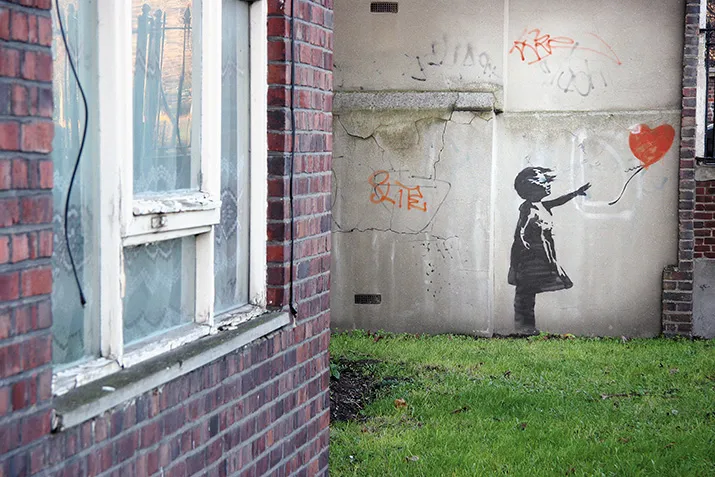
The people—and the apes and rats—he drew in these early days have a strange, primitive feel to them. My favorite is a piece that greets you when you enter the Pierced Up tattoo parlor in Bristol. The wall painting depicts giant wasps (with television sets strapped on as additional weapons) divebombing a tempting bunch of flowers in a vase. Parlor manager Maryanne Kemp recalls Banksy’s marathon painting session: “It was an all-nighter.”
By 1999, he was headed to London. He was also beginning to retreat into anonymity. Evading the authorities was one explanation—Banksy “has issues with the cops.” But he also discovered that anonymity created its own invaluable buzz. As his street art appeared in cities across Britain, comparisons to Jean-Michel Basquiat and Keith Haring began circulating.
Banksy’s first London exhibition, so to speak, took place in Rivington Street in 2001, when he and fellow street artists convened in a tunnel near a pub. “We hung up some decorators’ signs nicked off a building site,” he later wrote, “and painted the walls white wearing overalls. We got the artwork up in 25 minutes and held an opening party later that week with beers and some hip-hop pumping out of the back of a Transit van. About 500 people turned up to an opening which had cost almost nothing to set up.”
In July 2003, Banksy mounted “Turf War,” his breakthrough exhibition. Staged in a former warehouse in Hackney, the show dazzled the London art scene with its carnival-atmosphere display, which featured a live heifer, its hide embellished with a portrait of Andy Warhol, as well as Queen Elizabeth II in the guise of a chimpanzee.
Late that year, a tall, bearded figure in a dark overcoat, scarf and floppy hat strolled into Tate Britain clutching a large paper bag. He made his way to Room 7 on the second level. He then dug out his own picture, an unsigned oil painting of a rural scene he had found in a London street market. Across the canvas, which he had titled Crimewatch UK Has Ruined the Countryside for All of Us , he had stenciled blue-and-white police crime-scene tape.
During the next 17 months, always in disguise, Banksy brought his own brand of prankster performance art to major museums, including the Louvre. There, he succeeded in installing an image of the Mona Lisa plastered with a smiley-face sticker. In New York City, he surreptitiously attached a small portrait of a woman (which he had found and modified to depict the subject wearing a gas mask) to a wall in the Metropolitan Museum of Art. The museum took it in stride: “I think it’s fair to say,” spokeswoman Elyse Topalian told the New York Times , “it would take more than a piece of Scotch tape to get a work of art into the Met.”
Banksy became an international star in 2005. In August, he arrived in Israel, where he painted a series of images on the West Bank’s concrete wall, part of the barrier built to try to stop suicide bombers. Images of a girl clutching balloons as she is transported to the top of a wall; two stenciled children with bucket and spade dreaming of a beach; and a boy with a ladder propped against the wall were poignant meditations on the theme of escape.
Two months after returning from Israel, Banksy’s London exhibition “Crude Oils” took the art of the subversive mash-up to new heights—Claude Monet’s Water Lilies reworked to include trash and shopping carts floating among lily pads; a street hooligan smashing the window depicted in a reimagining of Edward Hopper’s Night Hawks . A signature Banksy touch included 164 rats—live rats—skittering around the gallery and testing critics’ mettle.
There was an inevitability to Banksy’s incursion into Los Angeles with the show “Barely Legal” in September 2006. “Hollywood,” he once said, “is a town where they honor their heroes by writing their names on the pavement to be walked on by fat people and peed on by dogs. It seemed like a great place to come and be ambitious.” Crowds of 30,000 or so, among them Brad Pitt, were in attendance. “[Banksy] does all this and he stays anonymous,” Pitt told the LA Times , almost wistfully. “I think that’s great.”
The exhibition centerpiece was an 8,000-pound live elephant, slathered in red paint and overlaid with a fleur-de-lis pattern. L.A.’s outspoken animal-rights advocates were incensed; the authorities ordered the paint to be washed off. Fliers distributed to the glittering crowd made the point that “There’s an elephant in the room...20 billion people live below the poverty line.”
In February 2008, seven months before the collapse of Lehman Brothers, New York’s rich and famous gathered at Sotheby’s for a night of serious spending. The event, organized by Bono, artist Damien Hirst, Sotheby’s and the Gagosian Gallery, turned out to be the biggest charity art auction ever, raising $42.5 million to support AIDS programs in Africa.
Banksy’s Ruined Landscape , a pastoral scene with the slogan “This is not a photo opportunity” pasted across it, sold for $385,000. A Vandalized Phone Box , an actual British phone booth bent nearly 90 degrees and bleeding red paint where a pickax had pierced it, commanded $605,000. Three years later the buyer was revealed to be Mark Getty, grandson of J. Paul Getty.
Banksy took on the medium of film in Exit Through the Gift Shop , an antic, sideways 2010 documentary on the creation and marketing of street art. The New York Times described it as paralleling Banksy’s best work: “a t rompe l’oeil : a film that looks like a documentary but feels like a monumental con.” It was short-listed for an Oscar in the 2010 documentary category.
When the Museum of Contemporary Art, Los Angeles put on its comprehensive survey of street art and graffiti in 2011, Banksy was well represented in the field of 50 artists. The show was a high-profile demonstration of the phenomenon that has come to be known as the “Banksy effect”—the artist’s astounding success in bringing urban, outsider art into the cultural, and increasingly profitable, mainstream.
It could be said that Banksy’s subversiveness diminishes as his prices rise. He may well have reached the tipping point where his success makes it impossible for him to remain rooted in the subculture he emerged from.
The riots in the Stokes Croft area of Bristol in spring 2011 offer a cautionary tale. The episode began after police raided protesters, who were opposed to the opening of a Tesco Metro supermarket and living as squatters in a nearby apartment. The authorities later said that they took action after receiving information that the group was making petrol bombs. Banksy’s response was to produce a £5 “commemorative souvenir poster” of a “Tesco Value Petrol Bomb,” its fuse alight. The proceeds, he stated on his website, were to go to the People’s Republic of Stokes Croft, a neighborhood-revival organization. Banksy’s generosity was not universally welcomed. Critics denounced the artist as a “Champagne Socialist.”
He has countered this kind of charge repeatedly, for instance, telling the New Yorker by e-mail: “I give away thousands of paintings for free. I don’t think it’s possible to make art about world poverty and trouser all the cash.” (On his website, he provides high-resolution images of his work for free downloading.)
The irony, he added, that his anti-establishment art commands huge prices isn’t lost on him. “I love the way capitalism finds a place—even for its enemies. It’s definitely boom time in the discontent industry. I mean how many cakes does Michael Moore get through?”
While the value of his pieces soars, a poignancy attends some of Banksy’s creative output. A number of his works exist only in memory, or photographs. When I recently wandered in London, searching for 52 previously documented examples of Banksy’s street art, 40 works had disappeared altogether, whitewashed over or destroyed.
Fittingly, the latest chapter in the enigmatic Banksy’s saga involves an unsolved mystery. This summer, during the London Games, he posted two images of Olympic-themed pieces online—a javelin thrower lobbing a missile, and a pole vaulter soaring over a barbed-wire fence. Naturally, a Banksyan twist occurs: The locations of this street art remain undisclosed. Somewhere in London, a pair of new Banksys await discovery.
Related Books

Wall and Piece

Banksy.: You Are an Acceptable Level of Threat

Banksy: The Man Behind the Wall
Get the latest Travel & Culture stories in your inbox.

Arguably the most controversial street artist in the world, Banksy ’s works have become a subculture in their own right. Banksy’s political statements and disruptive vision have impacted cities across the globe at vital moments in modern history, provoking alternative viewpoints and encouraging revolution in the art world. His identity remains unknown, even after more than 30 years of involvement in the global graffiti scene. He has worked in many street art mediums and in many styles, breaking down the boundaries and expectations of street art critics. His work includes powerful, often controversial images, encouraging the rapid spread of his name and work across the internet. Today, his iconic works have been re-shared and repurposed beyond measure.
Banksy’s early days in graffiti art
Banksy began his graffiti career by admiring the works of Blek Le Rat. He often recycled the artist’s old ideas, moulding his own distinctive voice and style as he went. Initially, he was part of a graffiti crew in Bristol by the name of DryBreadZ Crew or DBZ. Soon after, he began to partner with Inkie , another notable graffiti street artist.
At the age of 18, Banksy was nearly caught vandalizing public spaces by police. As his crew fled from the scene, Banksy was stuck hiding beneath a dustbin van. Banksy noticed stencil letters sprayed onto the truck, and, as he had been looking for a faster way to paint at the time, he decided stencilling would be his new graffiti style .
Banksy’s works often take the form of multi-layered stencils combined with other media sources. He sometimes includes objects that already exist on his chosen ‘canvas,’ such as street signs and fire hydrants, to turn his work into striking street art installations. His artwork is often satirical, combining dark humour with messages about art, philosophy, and politics.
By the early 2000s, Banksy had relocated from Bristol to London , where he began to gain notoriety; but, at the same time, his international work was taking off. He soon decided to travel to Palestine and the West Bank, where he stencilled nine now-iconic images onto the newly-erected West Bank Wall, including ‘Love is in the Air.’ These images were an instant hit and exploded online.
At this time, Banksy’s silkscreen prints and stencil paintings were racking up record-breaking sales in storied art auctions such as Sotheby’s and Bonhams of London . These successful sales marked Banksy’s dramatic entry into the commercial art world. In 2010, Banksy assumed the role of author and filmmaker for his film ‘Exit Through the Gift Shop.’
Who is Banksy?
Very little is known about Banksy himself, as he refuses to be interviewed and carefully maintains his anonymity. A world-renowned mystery man, Banksy has risen through the ranks to become one of the world’s greatest street artists partly by cultivating in his collectors an urgency and desire to unveil his character. Street art fanatics are consistently impressed by the far-reaching scope, variety, and bravery of every artwork he delivers, but are always left wanting more. This tactic encourages viewers to explore a completely new perspective or idea, often inspiring both amateur and professional artists. This inspiration is also known as the “ Banksy Effect .”
A number of claims have been made over Banksy’s identity, fuelling media interest. Most recently, many sources, including an entire newspaper publication, suggested he was a Bristol native by the name of Robin Gunninham. Though the prospect of uncovering Banksy’s identity would allow for a greater understanding of his motives and mission, no claim had ever been confirmed. His identity has reputedly even been concealed from his family.
Banksy artwork
In October 2013, Banksy undertook a month-long residency in New York entitled ‘Better Out Than In. ’ During this time, he unveiled a new piece of work every day. On Day 13, the artist disguised himself as a typical street vendor and set up a stand in Central Park, where he sold black-and-white original paintings for $60. Only eight pieces of art were sold. The following day, Banksy authenticated those eight canvases on his website, alongside the message: “Yesterday I set up a stall in the park selling 100% authentic original signed Banksy canvases. For $60 each”. A year after, ‘Winnie the Pooh’, purchased during Banksy’s New York residency, sold for £56,250 on July 2nd 2014 at Bonhams in London.
In the summer of 2015, Banksy opened the dystopian theme park Dismaland in the seaside resort of Weston-super-Mare. Prepared entirely in secret, the project unveiled 10 new works by Banksy as well as works from 58 other artists.
Banksy went on to participate in the designing of the Walled Off Hotel in Bethlehem in 2017, opposite the Israeli West Bank Barrier. With nine rooms designed by Banksy himself, guests could literally sleep inside a work of art. Originally intended as a temporary and provocative piece of installation art, the Walled Off Hotel rapidly became a top tourist attraction. Alongside the spot on which Jesus was reputedly born, a traditional pilgrimage site, the controversial 700 km-long wall is now a surprising tourist site.
Banksy’s relationship with tourism is a complex one; while he often stimulates it, he also regularly denounces it because of its negative effects. To criticise the mass tourism that is endangering the Italian city of Venice at the Biennale in 2019, Banksy unveiled ‘Venice in Oil,’ a series of nine oil paintings which, when placed together, depict a large cruise ship.
In October 2018, a painting by the anonymous street artist sold at Sotheby’s auction house in London for £1.04 million. Shortly after the hammer came down, the print of Banksy’s 2006 ‘Girl with Balloon’ began to pass through a shredder installed in the frame, destroying half of it. “It appears we just got Banksy-ed,” reported Alex Branczik, Sotheby’s Senior Director and Head of Contemporary Art in Europe. The piece was a famous Banksy print known as ‘ Girl with Balloon ’ created back in 2006. Banksy’s balloon girl , which was voted UK’s best-loved work of art in 2017, became the first instance of a self-destructing painting. Banksy posted a video to his Instagram account to confirm the move was intentional and demonstrate how he built a shredding device into the large golden frame. The work was then given a new title: “ Love is in the Bin “. One less than savvy Banksy owner actually shredded their own Banksy print in the hope the stunt would add value to their investment, but was very disappointed.
In October 2019, another Banksy artwork took the country by storm. Amidst the political controversy at the time, Banksy released ‘Devolved Parliament;’ a painting that depicts the House of Commons overtaken by apes. It sold at Sotheby’s for an astonishing £9.9 million, making it the most expensive Banksy painting sold up to this date . In typical Banksy fashion, he responded to the sale on Instagram with a line from Robert Hughes: “But the price of a work of art is now part of its function, its new job is to sit on the wall and get more expensive.”
In a move that was characteristically charitable , Banksy donated a series of three paintings to auction in 2020, entitled ‘Mediterranean Sea View’, to raise money for a hospital in Bethlehem. The oil paintings were in a detailed, traditional style that had grown more prominent in Banksy’s work around this time. Of course, the stunning landscapes came with a Banksy twist: life jackets washed up on the shore, intended to highlight the growing European migrant crisis.
Banksy’s ability to consistently break and challenge his own records continued to amaze the art market when, in October 2020, Banksy’s reinterpretation of Monet’s famous waterlilies, entitled ‘Show Me The Monet’ sold at auction for £7.5 million. This made it the second most expensive of his works to sell at auction. The piece was part of a series of remixed masterpieces and commented on the threat that society’s wasteful consumerism poses to the natural world.
In response to the global Coronavirus pandemic in 2020, Banksy hung a brand-new black and white artwork, depicting a young boy playing with a ‘superhero’ NHS nurse doll, in the foyer of Southampton General Hospital . He released a statement thanking the NHS for their work and hoping that the painting brightened up the hospital. The piece was later titled ‘Game Changer.’ On the one-year anniversary of the UK entering into lockdown, ‘Game Changer’ sold at auction for £16.8 million, with all proceeds donated to the NHS. This price far exceeded all expectations and firmly secured this piece as the most expensive Banksy ever sold.
Banksy’s artistic endeavours continue to take him around the world. Artworks have cropped up in Australia, France, Italy, the United States, Canada, Jamaica, and Israel, and are instantly protected and revered.
Banksy links
- www.banksy.co.uk
- instagram.com/banksy
Banksy pictures

You might be interested in


Don Mateo’s interview

E.L.K paints in heart of Sydney

Giulio Vesprini’s biography is now live!

Sepe Biography Now Live!
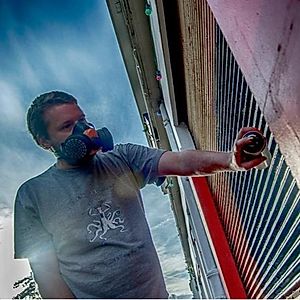
Interview : CodexUrbanus
Latest from blog.
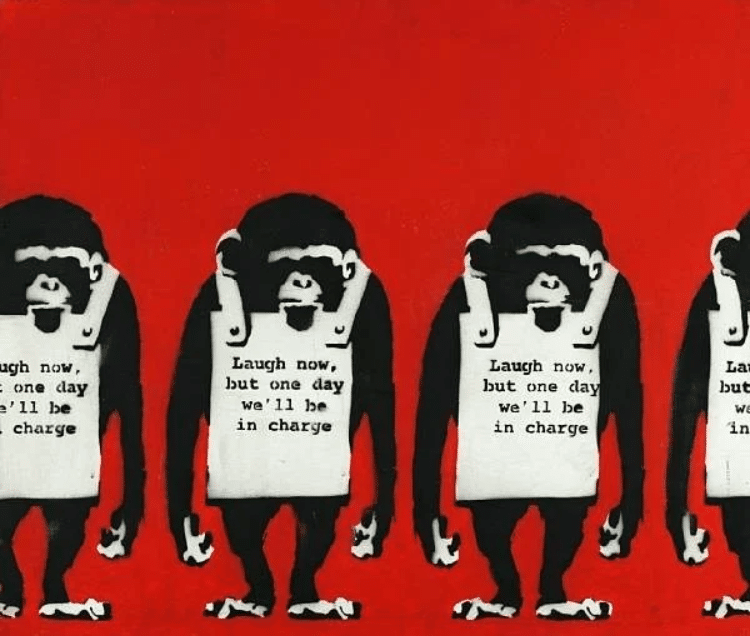
Banksy’s Trademark Battle: What’s The Story So Far?
Even though Banksy owns the copyright for each of his prints and murals, his masked identity

Braga Last1 mural in Southern France
Street artist, Braga Last1, also known as Tom Bragado, has just finished painting an amazingly realistic
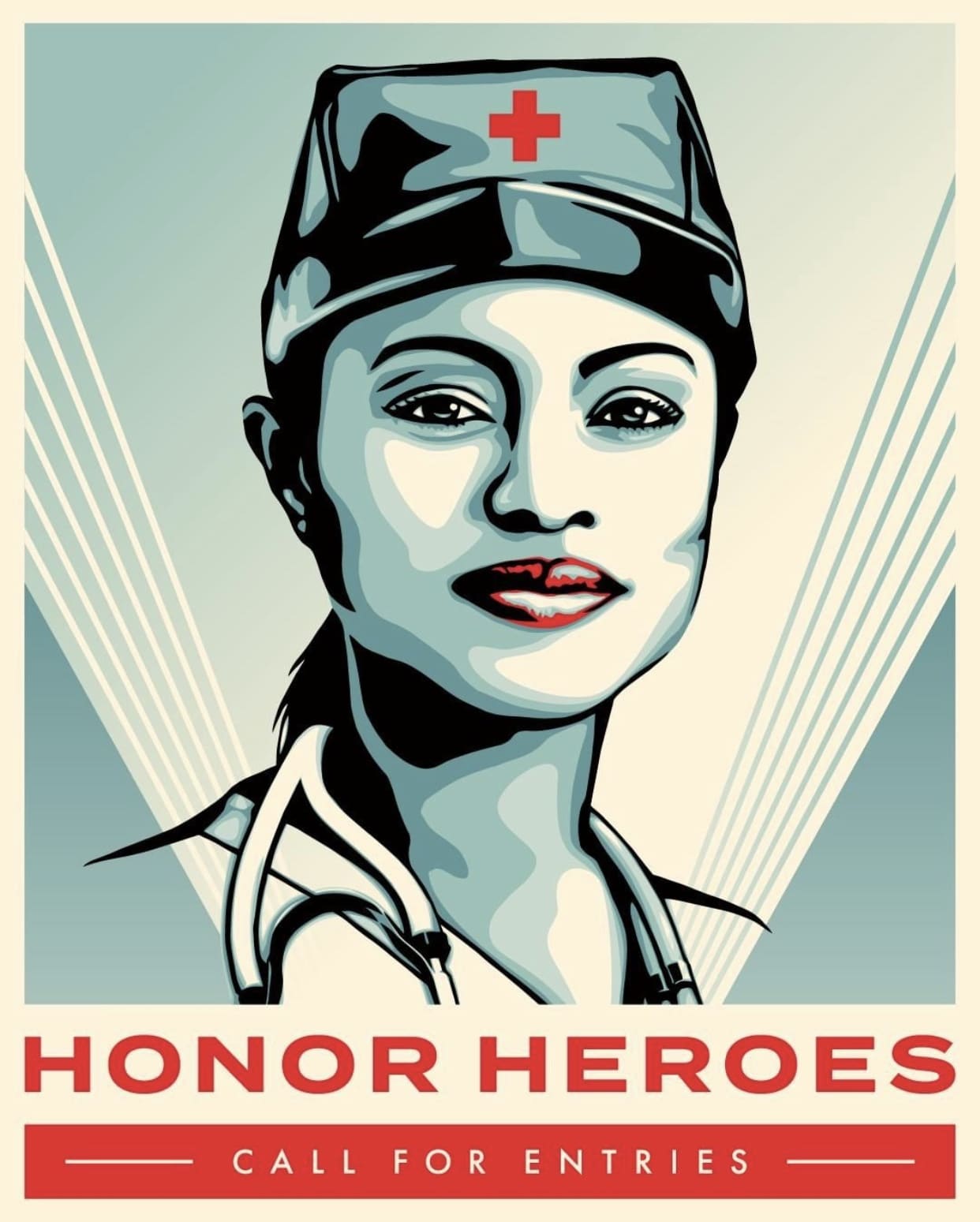
Shepherd Fairey #HonourHeroes
World-renowned street artist, Shepherd Fairey, has launched a new digital art collaboration in partnership with Adobe
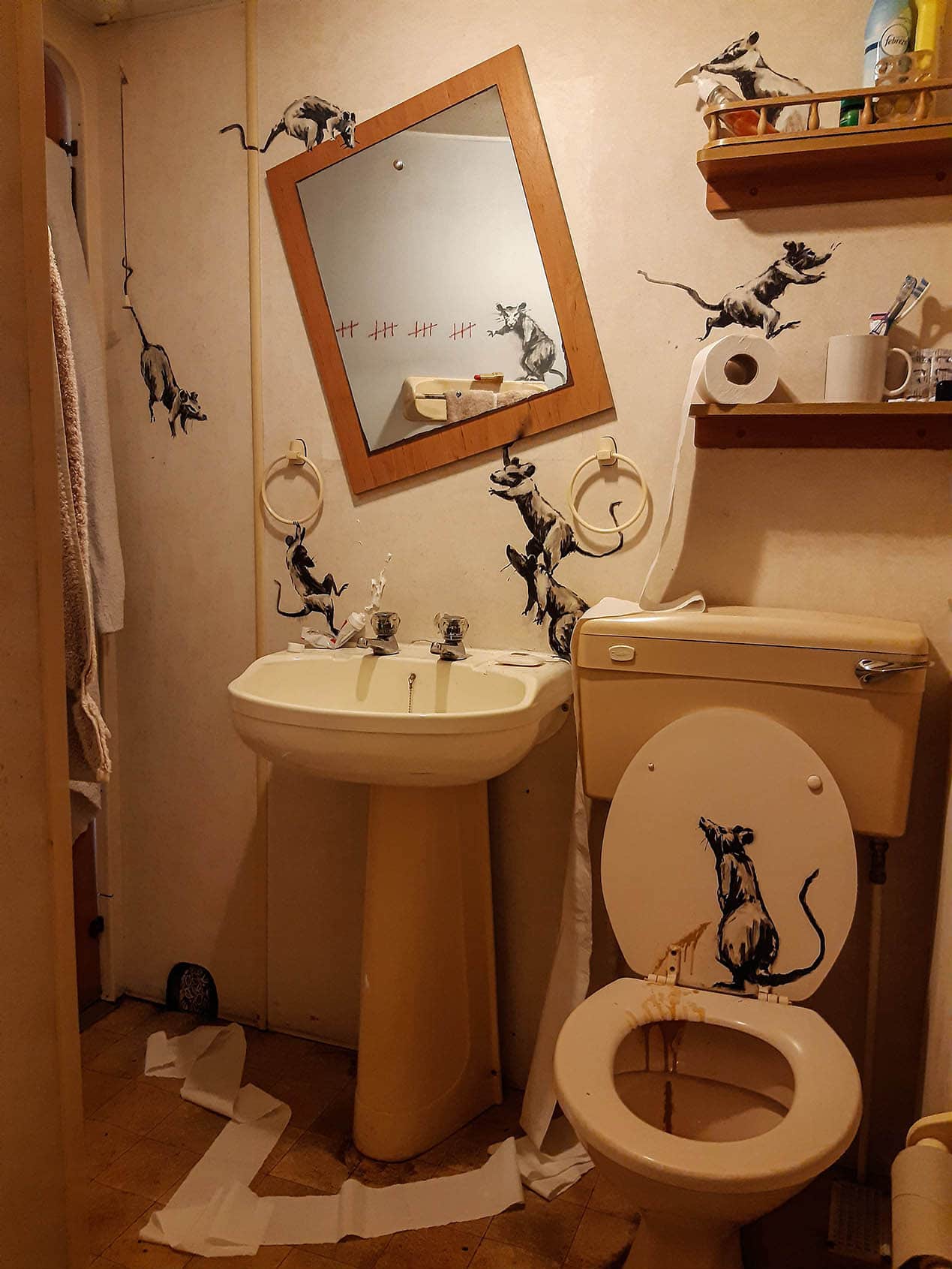
Banksy working from home during lockdown
While the coronavirus crisis has undoubtedly had a serious effect on the international street art scene,

Shepard Fairey and Sandra Chevrier celebrating gender equality
Last month Canadian artist Sandra Chevrier collaborated with American street artist and graphic designer Shepard Fairey
Privacy Overview
Pin it on pinterest.

Banksy – The Life and Works of Anonymous Street Artist Banksy
Banksy is a somewhat enigmatic character, known for his street art, political views, and films. Banksy’s artwork combines stenciled images with social commentary in a satirical yet dark manner. Banksy’s street art can be found worldwide on walls, streets, and bridges. The identity of the person behind these original Banksy artworks remains a mystery.
Table of Contents
Banksy’s Art and Life
Banksy’s art emerged from the underground scene of Bristol in the 1990s, which was known for the collaborative efforts of its musicians and artists. Banksy’s paintings were inspired by a member of Massive Attack, the trip-hop musical group. The member, 3D, was not only a musician but also a respected graffiti artist. Banksy’s street art can be found on walls in public spaces, and these Banksy paintings have often been sold – including the wall they were created on!
Original Banksy art can be classified as temporary art, although he has also sold pieces officially through his own company.

The True Identity of Banksy
The true identity of Banksy remains the subject of debate and speculation. He was once described by someone who had interviewed him as a white man in his late 20s with silver chains and a silver tooth. Banksy is of course, reluctant to share his real identity as graffiti art is illegal. According to most reports, he gained an interest in art when he was 14 years of age, was expelled from his high school, and had even been sent to prison for petty crimes. It is believed that he grew up in Bristol and moved to London in the early 2000s.
With anonymity comes rumors, and several people have been suspected of being the real Banksy over the years.
One of them is Robin Gunningham, a man born in Yate, close to Bristol, in 1973. Several of his ex-schoolmates have agreed with this possibility, and research carried out at the Queen Mary University was able to correlate the creation of Banksy’s artwork with where Gunningham was believed to have been at that time.

His friends from Bristol Cathedral School mention that at one point Gunningham started using the pseudonym Robin Banks, which he subsequently shortened to Banksy. Two album cover art designs from 1993 both have his signature on them, and the famous musician Goldie once referred to him as Rob in an interview.
Another Rob who has been the subject of much speculation is Robert Del Naja (3D) from Massive Attack, who is believed to be a good friend of Banksy (if not Banksy himself).
Early Career
Along with two other street artists known as Tes and Kato, Banksy was part of the DryBread’s Crew in Bristol who started as freehand artists in the early 1990s. Banksy drew inspiration from local artists as well as other members of the underground scene in Bristol such as Inkie and Nick Walker. Banksy met Steve Lazarides around this time, a local photographer who would help Bansky sell his work, and also later became his agent.
By the 2000s, Banksy’s street art had started incorporating stencils which allowed him to create pieces much quicker than with the freehand style he has previously employed.
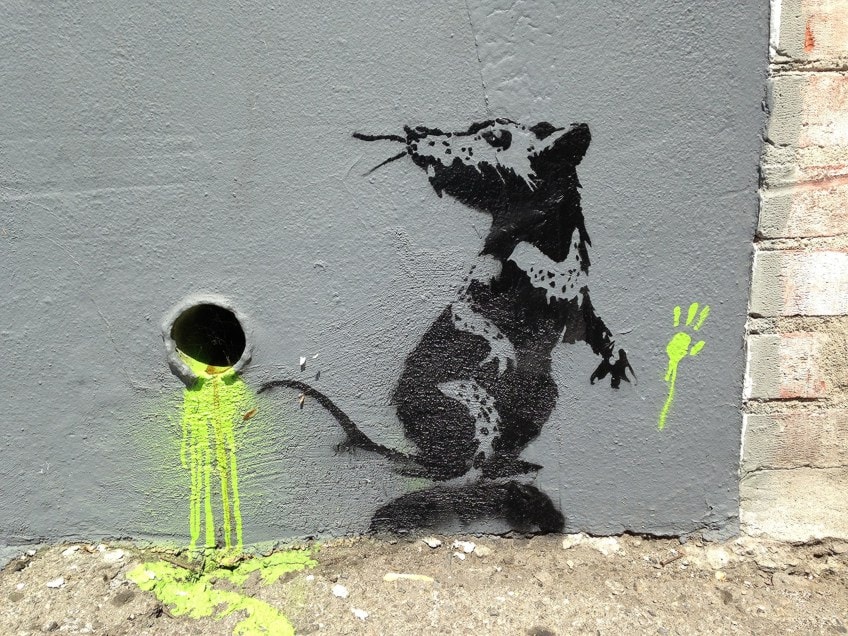
According to Banksy, he decided to change to stencils after being chased by police for his graffiti around the city streets. He hid under a massive rubbish bin on wheels and noticed the serial number stenciled underneath.
It then dawned on him that he could create a design with a stencil and quickly spray it onto any surface – and do it multiple times.
In 1997, the first large original Banksy artwork appeared in Stokes Croft on the wall of a building that once displayed advertising for an attorney firm. It depicted a teddy bear about to throw a Molotov cocktail at a group of police in riot gear and was titled The Mild Mild West .
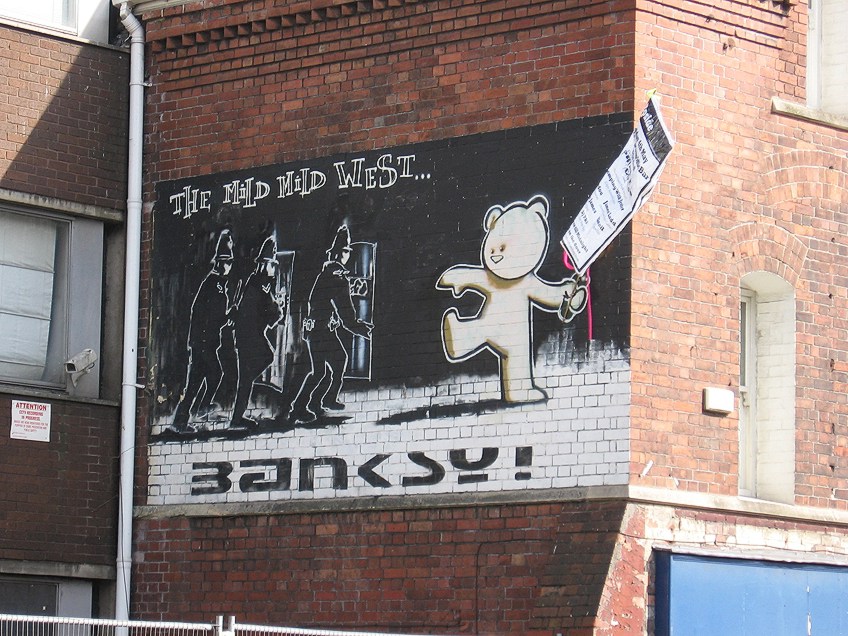
Banksy’s street art usually features a combination of satirical and humorous images along with a slogan to create a message that was anti-capitalist or anti-war. Not every one of Banksy’s paintings has been preserved though, with a few such as Gorilla in Pink Mask (2002) painted over either intentionally or unwittingly.
Early Exhibitions
Banksy held his first exhibition in Los Angeles on the 19th of July 2002, at a small gallery named 33 and a Third where it ran for a month. The exhibit was called Existencilism (a clever mix of the words existentialism and stencil) and featured Banksy’s artworks such as Leopard and Barcode (2002) and Love is in the Air (2002). At an exhibit titled Turf War , which took place in a warehouse in London in 2002, Banksy painted on various animals.
This caused an uproar among a few activists, one of which chained herself to one of the building’s railings in protest.
However, the paint was deemed safe for use on animal skin by the SPCA, which declared that the conditions for the animals were suitable enough for the exhibit to continue. Banksy’s paintings were also shown at exhibits such as his subversive works that took already existing pieces and adapted them in some manner, such as his version of Water Lily Pond by Monet , which now included litter strewn among the lilies as well as a discarded shopping trolley.
Fake Notes and More Exhibitions
Banksy printed fake banknotes in 2004, featuring Diana’s head instead o the Queen’s, and the words “Banksy of England” where it would usually say “Bank of England”. People even tried to use the fake cash in stores after an unknown person threw them out into the crowd at a festival that year. Ironically, these fake notes now sell on eBay for very real money. They were also thrown into the crowd at Reading Festival that year. A limited quantity of posters made from 10 undivided notes was printed and sold to commemorate the death of the Princes of Wales.
The American Numismatic Society posted images of these notes on their website in 2016, after which they received a stern email from the Bank of England stating that it was a criminal offense to publish images that were copyrighted by the bank, whether altered or not.
He found himself at odds with the animal activists in 2006 once again when he held a three-day exhibit in a warehouse that featured a painted live elephant. Banksy had stated that it was meant to represent a statement about poverty and that the elephant was used to paint and had been in many movies, yet due to continuing pressure, the elephant was not painted on the last day of the exhibit.
The Banksy Effect in the 2000s
Banksy produced a piece that featured the Queen as a lesbian, which was bought by Christina Aguilera for £25,000, and another of Banksy’s artworks featuring Kate Moss was bought for £50,400 in 2006. It was created in the same style as Warhol’s Monroe silkscreens.
Many other street artists gained popularity during this time, which came to be known as the “Banksy Effect”, as their own success seemed to be based on his.

Throughout 2007, he would continue to break his previous records for the asking sales prices of his works at auctions. During the second day of an auction of his works at Sotheby’s, Banksy uploaded an image of people inside an auction house with the caption “I can’t believe you idiots buy this s**t!”
In 2007, a house with a Banksy mural on one of the walls was put on the market for sale. However, all the prospective buyers wanted to have the mural removed once the property was bought and the owners of the house were not keen on that idea.
After not being able to find a buyer who would preserve the mural, they decided to rather put it up for sale through an online art gallery and market it as an original Banksy artwork with a house attached. A Banksy painting of two Pulp Fiction characters clutching bananas instead of guns was painted over by the cleaning staff of Transport for London.
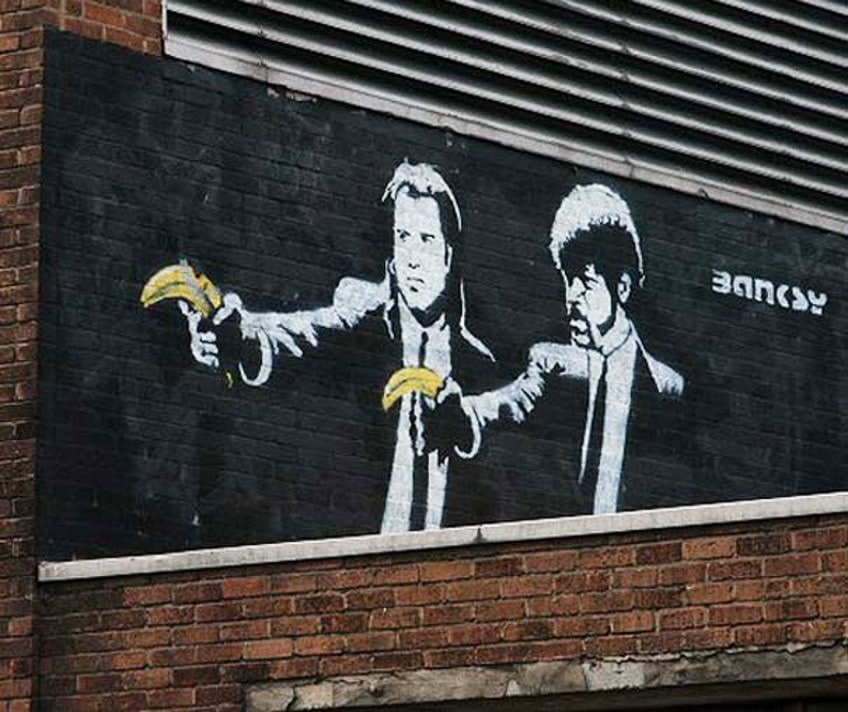
It was a much-loved piece and there was an outcry from residents over its removal, but the company replied that it devalued the area and encouraged crime and decay and that their cleaning staff was not paid to be art critics, they were paid to clean. Banksy then created another work on top of where the old one had been, this time featuring the characters wearing banana costumes.
A graffiti artist known as Ozone tagged over Banksy’s painting and wrote in the corner that if Banksy did a better job next time, he would leave it alone.
Later that year, Ozone would be killed by an underground train, and Banksy would pay tribute to the young artist and critic by painting a mural of him over the Pulp Fiction artwork that Ozone had once defaced. One of Banksy’s artworks Space Girl and Bird broke even further personal sales records, selling for £288,000 on the 27th of April 2007. In 2007 he was named the greatest living British artist, but in true Banksy fashion, he did not turn up to receive the award in order to maintain his anonymity.
It seems like everything Banksy does is done in a tongue-in-cheek manner, which makes it difficult to know what he is really about. If one had to go and search for his manifesto on his website, you would instead find a diary entry by a British Lieutenant which recounts a story about a shipment of lipstick that had been sent to a group of people who had just been liberated from a concentration camp in order to make them feel more human again. Banksy’s street art can be observed in a few scenes of the movie Children of Men (2006), such as a stencil of two law enforcement officers embracing.
Very few official exhibitions of his work were held, with many galleries selling his works without actually representing him, such as the first major exhibit of his work in New York at the Vanina Holasek Gallery, which featured more than 60 Banksy paintings and prints.
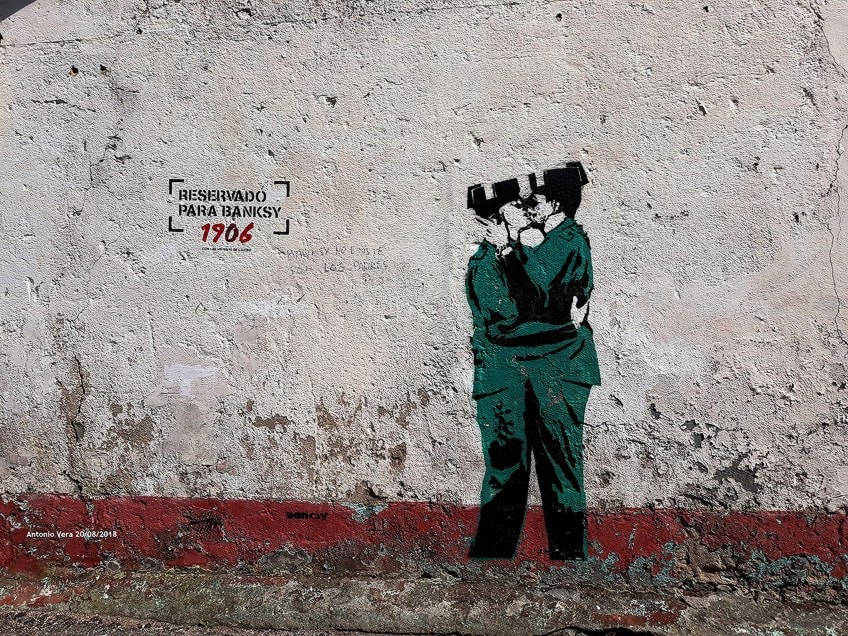
The Late 2000s
In 2008 a couple from Norfolk made the news when they sold their mobile home which featured original Banksy art on the walls. He had asked the couple 10 years prior if he could use it as a canvas in exchange for two tickets to the Glastonbury Festival. Originally the couple had paid only £1,000 for the mobile home, which they subsequently sold for £500,000.
Due to the ever-increasing popularity of Banksy’s street art at this time, there were many other artists who created works heavily inspired by his style, which sometimes made it hard to discern if it was an original Banksy artwork or simply another artist influenced by him.
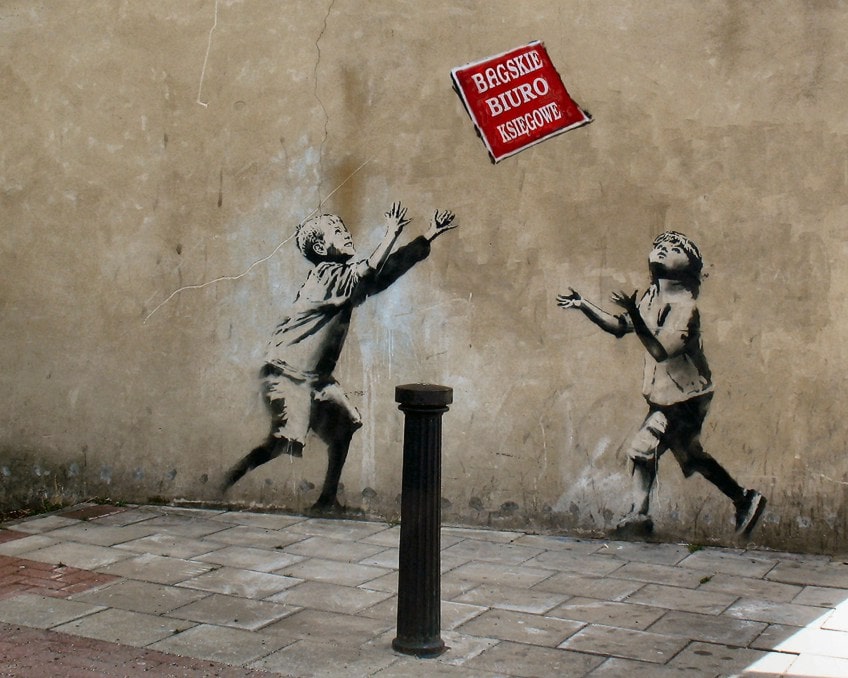
A stencil of a child writing “Take this society” appeared in the middle of the roundabout at Holland Park in 2008. Although there was no way of telling for sure, it was attributed to Banksy and removed after three days following remarks from a town councilor that it was not art but pure vandalism. Banksy then traveled to New Orleans in August of 2008 to paint murals on several derelict buildings to commemorate the third anniversary of the Hurricane Katrina disaster. On the 29th of that same month, a stencil painting of a Ku Klux Klan member having from a noose was found on a wall by residents in Ensley, Alabama, and it was subsequently attributed to Banksy.
After a few days, it had been sprayed over with black spray paint.
The Village Pet Store and Charcoal Grill was Banksy’s first official exhibit of his works in New York. As the name suggests, it was a statement on the polarities of our use of animals as either products or pets, with animatronic animals including a hen brooding over her chicks which were chicken nuggets pecking packets of barbecue sauce, and a rabbit putting makeup on in a mirror (they are often cruelly used to test cosmetic products). One of Banksy’s artworks titled One Nation Under CCTV was created in April of 2008. Six months later, the city council of Westminster announced that it would be painted over as it was illegal to create art on public property.
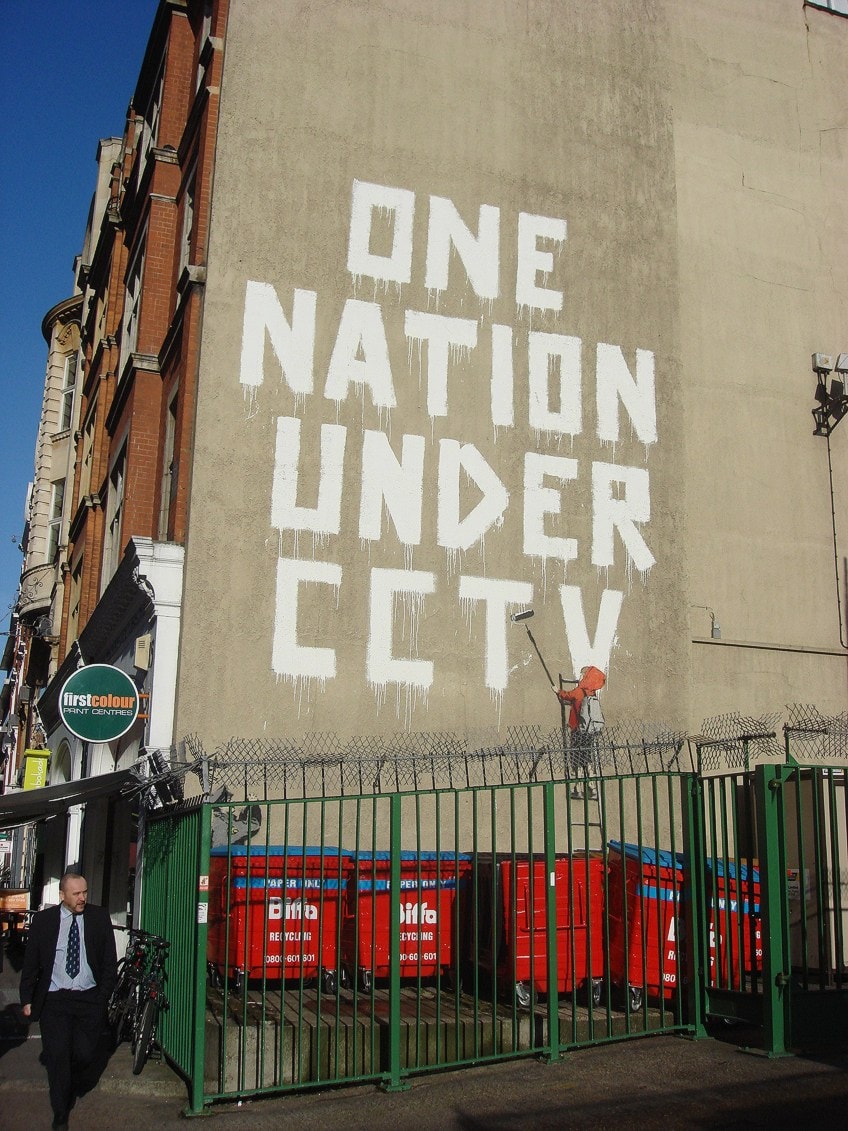
It further stated that it did not matter if the artist was well-known or not, it was still against the law and that Banksy should not be treated any differently to a child who might have done the same thing. It was believed that by leaving Banksy’s street art intact, they would effectively be telling every child with a spray can that it was okay to vandalize governmental property.
A Banksy artwork in Melbourne was destroyed in late 2008.
Locals tried to preserve what was left by covering it in a sheet of Perspex, but someone had poured silver paint through the gap on the top after that, rendering it completely covered. That year, he also held an exhibition in an old tunnel and invited artists from all over the world to come and exhibit their work.
In early 2009, the artist announced that he was cutting ties with his agent and that his works would now only be available through his company Pest Control . His largest exhibit to date would be held in June of 2009 at the Bristol City Museum, which featured 78 of Banksy’s new artworks. The show received great reviews and support, with over 8,500 guests attending on the first weekend alone and a total of 300,000 guests over the 12-week run.
One of Banksy’s paintings that had originally been painted on the side wall of a house in 2003 for a music video was painted over in 2009, after the local council in Hackney forced the owner of the house to have the painting removed as it was classified as graffiti despite the fact that owner had given his permission for the mural to be created on his own property. That same year, a graffiti war broke out between Banksy and another artist named King Robbo. Banksy had apparently painted over one of Robbo’s works, causing the artist to retaliate by painting over Banksy’s artwork.
This has resulted in many of Banksy’s street artwork being tagged over by artists in retaliation for his apparent lack of respect for other artists’ work.
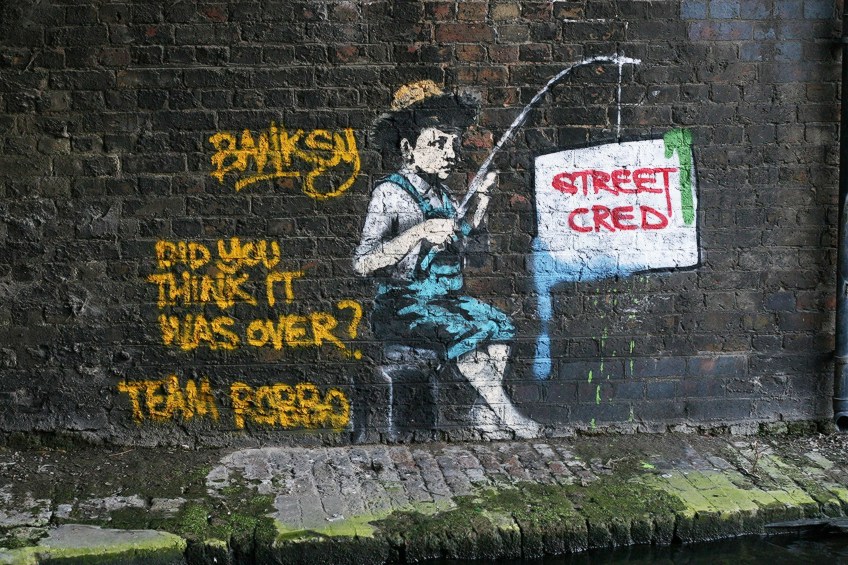
The United States and Exit Through the Gift Shop
In 2010, Banksy made his directorial debut in Exit Through the Gift Shop which premiered at the Sundance Film Festival. An altered version of his work, Forgive us Our Trespassing , was used in a poster for the movie and displayed at London Bridge Station. The Original Banksy artwork featured a boy kneeling with a halo spray painted around his head. In the poster, the halo had been removed due to its association with graffiti art. However, as should have been anticipated – a graffiti artist sprayed a bright halo around the head of the boy in the poster.
Following that incident, Transport for London removed the poster completely.
Five of Banksy’s artworks popped up around the city to coincide with the release of the film, with Banksy paying various landlords around Chinatown $50 each to stencil his works on their walls. A month later, several more of Banksy’s paintings were found around the city of Ontario in Canada, however, very few of them still remain, with the majority removed or painted over in the last 10 years. Banksy’s paintings would also appear around Detroit such as one piece that depicted a boy holding a spray can with the words “I remember when this was all trees” written next to him. It was subsequently removed by the 555 Gallery, which intended to preserve it at their exhibition space in Detroit and not sell it.
The documentary film was nominated for Best Documentary Feature at the 2010 Academy Awards.
In a statement released by Banksy, he jokingly said that he was surprised to be nominated, and that even though he did not agree with the idea of ceremonies for awards, he was willing to make an exception for those he had been nominated for, and that the only naked person painted in gold previously in his home was himself.
In the days leading up to the awards ceremony, the streets of Los Angeles were covered in Banksy’s street art, and many people wondered if perhaps he planned to attend the ceremony in disguise in case he won. He did not win though, so we will never know if it was something he had planned to do or just pure speculation.
The Last 10 Years
In 2011, Banksy took part in a campaign in his hometown of Bristol which sought to stop the opening of a Tesco store in their neighborhood, feeling it would affect the family-owned stores in the area. He created a piece featuring a stenciled Tesco bottle that had been made to look like a petrol bomb.
The campaign had led to violence between the demonstrators and police on the streets of Stokes Croft, and Banksy had created the poster to raise funds to get those who had been arrested during the clashes released.
In 2012, one of his artworks in Melbourne that were created during his visit in the 1990s, Parachuting Rat was destroyed by accident by plumbers who were trying to install new pipes in the building on which the work had been painted.
In 2013, an artwork of Banksy was removed from the side of a store in north London and later appeared in the catalog for Miami’s Fine Arts Auctions. This news badly upset the residents of the town from which it had been taken, who viewed it as the theft of an artwork created for their town. The auction house insisted that everything was above board and that there had been no wrongdoing, yet the local councilor continued to campaign for the return of the artwork.
On the day the work was meant to be auctioned, the gallery announced that it would no longer be put up for sale.
Also in 2013, Banksy set up a pop-up boutique that featured around 25 of his paintings that were for sale at $60 each to tourists. He posted a message to his website noting that this would be the only time that the boutique would be there. The stall was watched over by an older gentleman who did not sell a single piece in the first four hours after it had been open. Even the old man seemed surprised when a few of them managed to sell later in the day. Two of those sold paintings were later sold at an auction for $214,000.
In 2015, he visited the Gaze strip and painted a few pieces, such as a small kitten on the side of a house that had been destroyed by Israeli forces. It was an extremely impactful scene to the artist, yet he felt that if he wanted the photo to gain any traction online, then it should feature a kitten, as that seemed to be the only thing that caught people’s attention online.
Although he did not intend on taking a side in the conflict, he stated that upon seeing the devastation of the entire neighborhood, he felt the hopelessness that the locals were experiencing, and noted that these kinds of environments were not good for raising children, only vengeful people who would want to exact revenge.
In 2017, to commemorate the 100th anniversary of the control of Palestine by the British, the artist funded the construction of Bethlehem’s Walled Off Hotel, which is open to the public and features rooms designed by artists such as Dominique Petrin, Sami Musa, and Banksy himself. The hotel also features an art gallery. In 2018, one of Banksy’s paintings named Balloon Girl sold for £1.04 million at an auction in Sotheby’s. Little known to anyone besides Banksy himself, the frame of the artwork contained a paper shredder, and just as the painting was sold, an alarm bell started ringing, and the painting started to be pushed through the shredder, exiting through the bottom of the frame in cut strips.
The auction house acknowledged to the press that it had been a prank pulled by the artist, and the resulting coverage from the press made it possibly the most famous stunt ever pulled off in the art world, with some auctioneers estimating that in its shredded state, the work had most likely doubled in value. When asked about why he has shredded his own work, he replied that the urge to destroy something is itself a creative urge – which is something that Picasso had actually originally said.
It is not known how the shredder was activated, although it has been suggested that Banksy was among those present at the auction, with some even suggesting that he can be seen in video footage, holding a camera and filming the shredding.
In a video posted to social media by the artist, he shows how he constructed the piece and how it was actually meant to shred the entire painting and not stop towards the ends as it had done at auction. The woman who had won the bid for the artwork opted to go through with the transaction, and the artwork was retitled Love Is in the Bin . Although critics say that artwork was lost at the auction, the artist himself believes that it was only born upon shredding, adding that it was in fact, the first artwork to be created at its own auction.
We know very little about the person behind the art, but maybe that’s the point. In a day when often the concept of celebrity is often more important than the talents they possess, it is refreshing for an artist to take a backseat to their own art. However, that is not totally true with Banksy, as although we might not know his identity, his persona has still been a large part of his appeal and works. His style of art is rebellious, anti-establishment, and driven by social statements about the world around him. Banksy’s artwork belongs to both no one and everyone simultaneously, regarded as both petty vandalisms to be removed, and national heritage to be preserved.
Take a look at our Banksy art webstory here!
Frequently Asked Questions
Who created banksy’s paintings.
The artist known as Banksy remains a figure clouded in secrecy regarding his true identity. There have been many individuals put forward as potentially being the real Banksy through the years, such as Rob Gunningham. There have even been studies carried out at a university which aimed to try and correlate the creation of the works with Gunningham’s apparent movements geographically from year to year. Even his old schoolmates think that Rob is Banksy, as they recall when he changed his name to Robin Banks, and friends would call him Banksy for short. There have been several other people suspected of being the artist through the years, from a councilman who was eventually compelled to leave his job rather than spend his time trying to prove he wasn’t someone else, to the founding member of the music group Massive Attack, who were apparently good friends of Banksy.
What Is Banksy’s Street Art About?
Banksy is able to impart social commentary in an often-humorous manner, providing a satirical look at the current state of the world. His works are created to spark conversation and debate on a variety of subjects such as war, famine, natural disasters, and capitalism. That is not to say, however, that he does not make any money from his art. Banksy’s paintings have increased in value at auction steadily year after year, and his Girl with Balloon sold for £1,4 million at Sotheby’s in 2018. As the artwork was sold, though, the paper shredder that had been built into the picture frame was activated, causing the entire painting to be stripped into shreds.

Isabella studied at the University of Cape Town in South Africa and graduated with a Bachelor of Arts majoring in English Literature & Language and Psychology. Throughout her undergraduate years, she took Art History as an additional subject and absolutely loved it. Building on from her art history knowledge that began in high school, art has always been a particular area of fascination for her. From learning about artworks previously unknown to her, or sharpening her existing understanding of specific works, the ability to continue learning within this interesting sphere excites her greatly.
Her focal points of interest in art history encompass profiling specific artists and art movements, as it is these areas where she is able to really dig deep into the rich narrative of the art world. Additionally, she particularly enjoys exploring the different artistic styles of the 20 th century, as well as the important impact that female artists have had on the development of art history.
Learn more about Isabella Meyer and the Art in Context Team .
Cite this Article
Isabella, Meyer, “Banksy – The Life and Works of Anonymous Street Artist Banksy.” Art in Context. September 15, 2022. URL: https://artincontext.org/banksy/
Meyer, I. (2022, 15 September). Banksy – The Life and Works of Anonymous Street Artist Banksy. Art in Context. https://artincontext.org/banksy/
Meyer, Isabella. “Banksy – The Life and Works of Anonymous Street Artist Banksy.” Art in Context , September 15, 2022. https://artincontext.org/banksy/ .
Similar Posts

William Turner – The Life and Romantic Works of J. M. W. Turner

Kara Walker – Interesting Facts About Artist Kara Walker
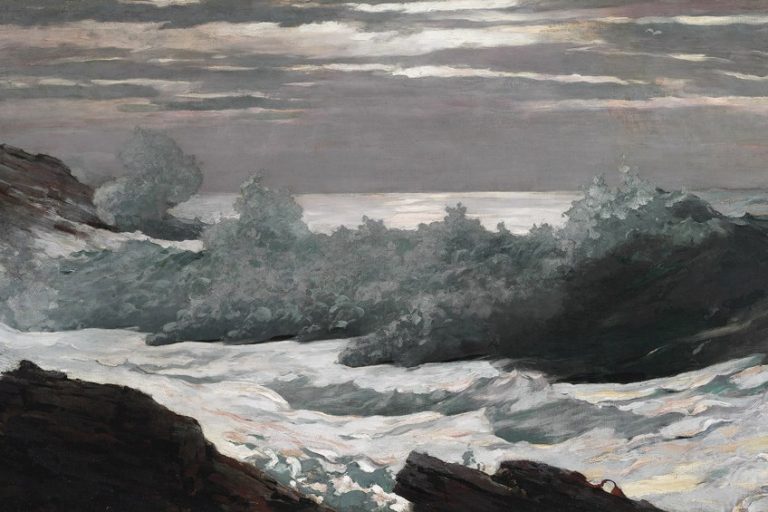
Winslow Homer – The Life and Paintings of the Famous Watercolor Artist

Helen Frankenthaler – Discover the Color Field Queen

Peter Max – A Look at the Life of the American Pop Artist

Ryder Ripps – The Controversial Voice of Contemporary Creativity
Leave a reply cancel reply.
Your email address will not be published. Required fields are marked *
Save my name, email, and website in this browser for the next time I comment.
The Most Famous Artists and Artworks
Discover the most famous artists, paintings, sculptors…in all of history!

MOST FAMOUS ARTISTS AND ARTWORKS
Discover the most famous artists, paintings, sculptors!

Banksy Rats & More
Global street art foundation, banksy, banksy & more banksy, 7 facts about banksy, beyond banksy: not another gift shop, the street museum of art, discover 11 of banksy's most famous murals, where to find 10 uk street art masterpieces, 12 banksy murals you can see on street view, discover this artist, related works from the web, balloon girl (2002), www.myartbroker.com girl with balloon by banksy background & meaning | myartbroker, love is in the bin (2006), www.myartbroker.com banksy's shredded artwork, love is in the bin, sells for record ..., flower thrower (2007), www.wikiart.org flower thrower - banksy - wikiart.org, game changer (2020), www.instagram.com theodore & c. | painting for saints or game changer is a 2020 ..., show me the monet (2005), allegro.pl banksy - show me the monet 12409460979 - allegro.pl, mobile lovers (2014), www.amazon.co.uk banksy mobile lovers canvas picture image 12"x16" framed ..., flying balloon girl (2005), www.artatelier.nl flying balloon girl - art atelier, untitled (2004), www.scaithebathhouse.com exhibitions | past | izumi kato - scai the bathhouse, the mild mild west (1999), www.rosss.ie the mild mild west by banksy - ross's auctioneers, “i mean, they say you die twice. one time when you stop breathing and a second time, a bit later on, when somebody says your name for the last time.”, more art movements, 7,115 items, more mediums, spray painting, 13,166 items, 162,897 items, 108,878 items, 7,389 items, 5,318 items, 63,405 items.

COMMENTS
Banksy biographer Will Ellsworth-Jones wrote in 2013 that Banksy "is an artist who has got people running around the city desperate to see his work before it gets painted over." Spray paint ... These also suggest some accessible resources for further research, especially ones that can be found and purchased via the internet. biography. Banksy ...
Banksy is anonymous British graffiti artist known for his antiauthoritarian art, often done in public places. He began using stencils in 2000 and developed a distinctive iconography of recognizable images such as rats and policemen. With wry wit and stealth, Banksy merged graffiti art with installation and performance.
Banksy, whose real identity remains unknown, is a street artist believed to have been born in Bristol, England, around 1974. He rose to prominence for his provocative stenciled pieces in the late ...
Banksy is a pseudonymous England-based street artist, political activist, and film director whose real name and identity remain unconfirmed and the subject of speculation. [2] Active since the 1990s, his satirical street art and subversive epigrams combine dark humour with graffiti executed in a distinctive stenciling technique. His works of political and social commentary have appeared on ...
When Time magazine selected the British artist Banksy—graffiti master, painter, activist, filmmaker and all-purpose provocateur—for its list of the world's 100 most influential people in ...
PDF | This study deals with how Banksy's art began and evolved. While analyzing political, cultural, and social problems, Banksy's works in which he... | Find, read and cite all the research ...
Prepared entirely in secret, the project unveiled 10 new works by Banksy as well as works from 58 other artists. Banksy went on to participate in the designing of the Walled Off Hotel in Bethlehem in 2017, opposite the Israeli West Bank Barrier. With nine rooms designed by Banksy himself, guests could literally sleep inside a work of art.
Banksy's art emerged from the underground scene of Bristol in the 1990s, which was known for the collaborative efforts of its musicians and artists. Banksy's paintings were inspired by a member of Massive Attack, the trip-hop musical group. The member, 3D, was not only a musician but also a respected graffiti artist. Banksy's street art ...
Banksy is a pseudonymous England-based street artist, political activist, and film director whose real name and identity remain unconfirmed and the subject of speculation. Active since the 1990s, his satirical street art and subversive epigrams combine dark humour with graffiti executed in a distinctive stenciling technique.
Banksy is a pseudonymous England-based street artist, political activist, and film director whose real name and identity remain unconfirmed and the subject... Home Explore